The synthesis of an RNA molecule from a DNA template is called
transcription
Note: RNA is synthesized from DNA by an enzyme known as RNA polymerase during a process called transcription.
Structural genes are also known as ____-encoding genes.
protein
In prokaryotes, a protein-encoding gene is first transcribed into an RNA molecule called ____ RNA.
messenger
In eukaryotes, the first product of a protein-encoding gene is a(n) ______.
Multiple choice question.
tRNA molecule
polypeptide molecule
rRNA molecule
primary mRNA transcript
primary mRNA transcript
Which is the proper matching of template and synthesized product for the process of translation?
Multiple choice question.
RNA template; DNA product
DNA template; protein product
DNA template; RNA product
RNA template; protein product
RNA template; protein product
The central dogma of genetics can be summed up by which of the following?
Multiple choice question.
mRNA → polypeptide → DNA
mRNA → DNA → polypeptide
polypeptide → mRNA → DNA
DNA → polypeptide → mRNA
DNA → mRNA → polypeptide
DNA → mRNA → polypeptide
In transcription, a(n) ______ template is used to synthesize ______.
Multiple choice question.
DNA; protein
DNA; RNA
RNA; protein
RNA; DNA
DNA; RNA
At the molecular level, ______ is the process by which a gene's information is used to produce a polypeptide or functional RNA molecule.
Multiple choice question.
genomic editing
genomic imprinting
gene expression
gene manifestation
gene expression
A structural gene encodes a(n) ______.
Multiple choice question.
polypeptide
tRNA molecule
rRNA molecule
polypeptide
The sequence in DNA that signals the end of transcription is known as the
terminator
The sequence of a gene's DNA that is transcribed extends from the end of the ____ to the end of the ____.
promoter; terminator
The synthesis of a polypeptide molecule from an mRNA template is called
translation
Note: Translation is the synthesis of polypeptide/ protein by polymerization of amino acids using mRNA sequence as template; it is carried out on ribosomes and tRNA serves to carry amino acids from cell pool to mRNA.
The strand of DNA that is used to produce the RNA transcript is called the ______ strand, while the opposite strand of DNA is called the ______ strand or non-template.
Multiple choice question.
coding; noncoding
template; coding
coding; template
noncoding; template
template; coding
Note: In transcription, a region of DNA opens up. One strand, the template strand, serves as a template for synthesis of a complementary RNA transcript. The other strand, the coding strand, is identical to the RNA transcript in sequence, except that it has uracil (U) bases in place of thymine (T) bases.
The flow of genetic information in a cell, from DNA to RNA to protein, is described as the ____ ____ of genetics.
central dogma
The nontemplate strand is also called the coding strand because it ______.
Multiple choice question.
has the same sequence as the mRNA but with A's instead of T's
is complementary and antiparallel to the mRNA
is complementary and parallel to the mRNA
has the same sequence as the mRNA but with T's instead of U's
has the same sequence as the mRNA but with A's instead of U's
has the same sequence as the mRNA but with T's instead of U's
The overall process by which the information within a gene is used to produce a functional product is called ____ ____.
gene expression
Note: Gene expression is the process by which the information encoded in a gene is turned into a function. This mostly occurs via the transcription of RNA molecules that code for proteins or non-coding RNA molecules that serve other functions.4 days ago
To which will proteins known as transcription factors bind and what is the outcome?
Multiple choice question.
DNA sequences to facilitate transcription
RNA molecules after transcription in order to enhance their conversion into proteins
RNA molecules during transcription in order to stabilize them
RNA polymerase to control transcription
DNA sequences to facilitate transcription
Which best describes a terminator of a gene?
Multiple choice question.
DNA sequence that specifies the end of translation
Molecule that binds to RNA polymerase to end RNA synthesis
Molecule that binds to a ribosome to end protein synthesis
DNA sequence that specifies the end of transcription
DNA sequence that specifies the end of transcription
Short stretches of DNA that are involved in the regulation of transcription are known as regulatory sequences or regulatory
elements
In a gene, the DNA is transcribed into RNA from the ______ to the ______.
Multiple choice question.
promoter; terminator
start codon; terminator
start codon; stop codon
promoter; stop codon
promoter; terminator
The ribosome-binding site is a sequence in bacterial ______ that is involved in ______.
Multiple choice question.
mRNA ; translation termination
mRNA ; translation initiation
DNA ; transcription termination
DNA ; transcription initiation
mRNA ; translation initiation
The base sequence of the RNA transcript is complementary to the ____ strand of DNA.
template, noncoding, or antisense
Note: RNA polymerase synthesizes an RNA transcript complementary to the DNA template strand in the 5' to 3' direction. It moves forward along the template strand in the 3' to 5' direction, opening the DNA double helix as it goes.
In bacteria, the ribosome-binding site is also called the ____-____ sequence.
Shine-Dalgarno
Note: In prokaryotes, the ribosome binding site (RBS), which promotes efficient and accurate translation of mRNA, is called the Shine-Dalgarno sequence after the scientists that first described it.
For protein-encoding genes, the nontemplate strand is also called the ____ strand.
coding or sense
Note: The nontemplate strand is referred to as the coding strand because its sequence will be the same as that of the new RNA molecule.
The mRNA contains groups of three nucleotides that specify the amino acid sequence of a polypeptide. These three-nucleotide groups are called
codons
Note: Each group of three consecutive nucleotides in RNA is called a codon, and each codon specifies either one amino acid or a stop to the translation process.
Proteins that bind to DNA and facilitate RNA synthesis are collectively called ____ ____.
transcription factors
Note: Proteins that bind to DNA and facilitate RNA synthesis are collectively called. Transcription factors. Following the binding of RNA pol to the promoter, the DNA is denatured into a bubble known as the. Open complex. What makes the transition to the elongation stage of transcription in bacteria.
The group of three nucleotides that signals the beginning of translation is called the ____ ____.
start codon or initiation codon
Note: A codon is a sequence of three DNA or RNA nucleotides that corresponds with a specific amino acid or stop signal during protein synthesis.
Regulatory elements are short stretches of ______ involved in the regulation of ______.
Multiple choice question.
RNA ; translation
DNA ; transcription
RNA ; transcription
DNA ; translation
DNA ; transcription
In bacteria, a short sequence in the mRNA provides a location that recruits the machinery to start translation. This sequence is called the ____-____ site.
ribosome binding; shine-dalgarno
True or false: Transcription occurs in two stages: initiation and termination.
False
Reason: This is false: Transcription occurs in three stages: initiation, elongation and termination.
The Shine-Dalgarno sequence is a short sequence in the ______ which provides a location for the binding of ______.
Multiple choice question.
mRNA of bacteria ; ribosomes
DNA of bacteria ; RNA polymerases
DNA of eukaryotes ; RNA polymerases
mRNA of eukaryotes ; ribosomes
mRNA of bacteria ; ribosomes
A triplet of nucleotides that corresponds to an amino acid is known as a(n) ______.
Multiple choice question.
operon
intron
codon
exon
codon
Note: The mRNA contains groups of three nucleotides that specify the amino acid sequence of a polypeptide. These three-nucleotide groups are called codons.
The enzyme that synthesizes RNA from a DNA template is called ____ ____.
RNA polymerase
The end of protein synthesis is specified by a ____ ____, which is a triplet of nucleotides in the mRNA molecule.
stop codon
Transcription is initiated by the binding of one or more transcription factors to the ____ region of a gene.
promoter
What is a promoter?
Multiple choice question.
A specific target sequence to which RNA polymerase binds.
An element that facilitates termination of transcription.
An environmental chemical that induces gene expression.
A regulatory protein that accelerates mRNA turnover.
A specific target sequence to which RNA polymerase binds.
The three stages of transcription are called ____, ____, and ____.
initiation
elongation
termination
The transcriptional start site is denoted as ______.
Multiple choice question.
-1
0
+1
+1
The first nucleotide that acts as a template for transcription is designated with the number ____. The nucleotides preceding this site are numbered in a(n) ____ direction, while those that come after it are numbered in a positive direction.
+1; negative
Which enzyme synthesizes RNA during transcription?
Multiple choice question.
RNA polymerase
RNA replicase
DNA replicase
DNA polymerase
RNA polymerase
Select all that apply
Which sequences of bacterial promoters are particularly important for transcription initiation?
Multiple select question.
The -10 site: 5' TTGACA 3'
The -10 site: 5' TATAAT 3'
The -35 site: 5' TATAAT 3'
The -35 site: 5' TTGACA 3'
The -25 site: 5' TTGACA 3'
The -25 site: 5' TATAAT 3'
The -10 site: 5' TATAAT 3'
The -35 site: 5' TTGACA 3'
Following the binding of RNA polymerase to the promoter, the DNA is denatured into a bubble known as the ____ ____.
open complex
Note: RNA polymerase can only make RNA by attaching to DNA and separating the two strands of the DNA double helix. This creates a short region of single-stranded DNA known as a “transcription bubble” or open complex.
The association of a sigma factor with the core enzyme forms a complex referred to as the RNA polymerase ____.
holoenzyme
The sequence in DNA that signals RNA polymerase where to begin transcription is called the
promoter
Note: A DNA sequence at which the RNA polymerase binds to start transcription is called a promoter.
The RNA polymerase holoenzyme is composed of several subunits including sigma factor whose primary role is to recognize the
promoter
The first DNA base used as a template for RNA synthesis is called the ____ ____ site.
transcriptional start
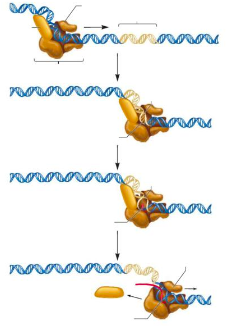
This diagram shows the ______ stage of transcription in ______.
Multiple choice question.
initiation; eukaryotes
elongation; bacteria
initiation; bacteria
elongation; eukaryotes
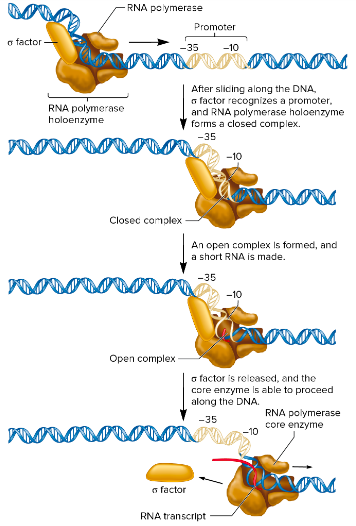
initiation; bacteria
(figure 12.7 the initiation stage of transcription in bacteria)
The following numbers represent the order of nucleotides in a bacterial promoter, going from left to right. Which of these is a correct representation of the conventional numbering system?
Multiple choice question.
-5 -4 -3 -2 -1 +1 +2 +3 +4 +5
-5 -4 -3 -2 -1 0 +1 +2 +3 +4 +5
+5 +4 +3 +2 +1 0 -1 -2 -3 -4 -5
+5 +4 +3 +2 +1 -1 -2 -3 -4 -5
-5 -4 -3 -2 -1 +1 +2 +3 +4 +5
Which regions of a bacterial promoter play a key role in promoting transcription?
Multiple choice question.
-35 and -10
-25 and +1
-100 and -10
-35 and -75
-75 and -35
-35 and -10
The term closed complex refers to what?
Multiple choice question.
The binding of the RNA polymerase core enzyme to the DNA
The final binding of the DNA to the newly-synthesized mRNA
The binding of the ribosome to the mRNA to initiate translation
The initial binding of the RNA polymerase holoenzyme to the promoter
The initial binding of the RNA polymerase holoenzyme to the promoter
In E. coli, the RNA polymerase holoenzyme is composed of the ______ plus ______.
Multiple choice question.
apoenzyme; sigma factor
core enzyme; rho factor
core enzyme; sigma factor
sigma factor; rho factor
apoenzyme; rho factor
core enzyme; sigma factor
What marks the transition to the elongation stage of transcription in bacteria?
Multiple choice question.
The formation of an open complex between RNA pol and DNA
The release of the sigma factor from the RNA pol holoenzyme
The release of the rho factor from the RNA pol holoenzyme
The formation of a closed complex between RNA pol and DNA
The release of the sigma factor from the RNA pol holoenzyme
Match the subunit of the bacterial RNA polymerase to its appropriate function.
α2
β and β'
ω
σ
Proper assembly of the holoenzyme
Proper assembly of the core enzyme
Recognition of the promoter
Catalytic synthesis of the RNA
- α2 Proper assembly of the holoenzyme
- β and β' Catalytic synthesis of the RNA
- ω Proper assembly of the core enzyme
- σ Recognition of the promoter
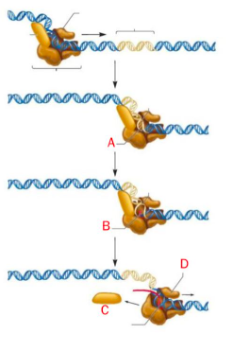
The initiation stage of bacterial transcription is shown in this figure. Match the letter to its appropriate description.
A
B
C
D
Open complex
RNA polymerase core enzyme
Closed complex
Sigma factor
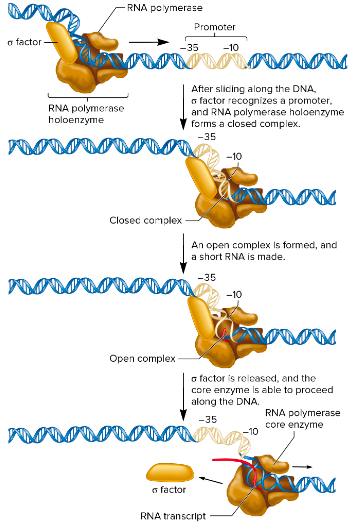
- A Closed complex
- B Open complex
- C Sigma factor
- D RNA polymerase core enzyme
RNA polymerase catalyzes the formation of a bond between the ______ group of one nucleotide and the ______ group on the previous nucleotide.
Multiple choice question.
5' phosphate; 3' hydroxyl
3' phosphate; 5' hydroxyl
3' hydroxyl; 5' phosphate
5' hydroxyl; 3' phosphate
5' phosphate; 3' hydroxyl
Part of the coding region of a gene is shown here: 5'-TTCCCATTTCGATGGGATACGATGG-3' 3'-AAGGGTAAAGCTACCCTATGCTACC-5' What is the sequence of the transcribed mRNA, assuming transcription proceeds left to right?
Multiple choice question.
5'-UUCCCAUUUCGAUGGGAUACGAUGG-3'
5'-AAGGGUAAAGCUACCCUAUGCUACC-3'
3'-UUCCCAUUUCGAUGGGAUACGAUGG -3'
3'-AAGGGUAAAGCUACCCUAUGCUACC-5'
5'-TTCCCATTTCGATGGGATACGATGG-3'
5'-UUCCCAUUUCGAUGGGAUACGAUGG-3'
Transcription in E. coli is initiated when the sigma factor of the RNA polymerase holoenzyme binds to the promoter region to form a(n) ____ ____.
closed cpmplex
During transcription, a T on the template DNA strand is paired with a(n) ____ in the mRNA, and an A on the template DNA strand is paired with a(n) ____ in the mRNA.
adenine or A
uracil, U, or Uracil
The transition from the initiation to the elongation phase of bacterial transcription is marked by the release of the
sigma factor
Note: the transition from initiation to elongation modes is marked by the release of the σ factor from the core polymerase
The template strand is read in the ______ direction, and the synthesis of the RNA transcript occurs in a ______ direction.
Multiple choice question.
3'-to-5'; 3'-to-5'
5'-to-3'; 5'-to-3'
3'-to-5'; 5'-to-3'
5'-to-3'; 3'-to-5'
3'-to-5'; 5'-to-3'
Select all that apply
Which of the following are the two mechanisms of transcription termination in E. coli?
Multiple select question.
Energy-dependent termination
Rho-dependent termination
Sigma-independent termination
Rho-independent termination
Energy-independent termination
Sigma-dependent termination
Rho-dependent termination
Rho-independent termination
During transcription, RNA is synthesized in what direction?
Multiple choice question.
5' to 3' for all genes
3' to 5' for some genes, and 5' to 3' for other genes
3' to 5' in prokaryotes, and 5' to 3' in eukaryotes
3' to 5' for all genes
5' to 3' in prokaryotes, and 3' to 5' in eukaryotes
5' to 3' for all genes
In E. coli, the transcription termination of certain genes requires an RNA-binding protein called
Rho or rho protein
Escherichia coli protein Rho is required for the factor-dependent transcription termination by an RNA polymerase and is essential for the viability of the cell. It is a homohexameric protein that recognizes and binds preferably to C-rich sites in the transcribed RNA.
The template strand of a gene has the sequence: 5'-ATTGCC-3'. What is the sequence of the transcribed mRNA?
Multiple choice question.
5'-GGCAAU-3'
5'-UAACGG-3'
5'-UAAGCC-3'
5'-AUUGCC-3'
5'-GCCAAU-3'
5'-CCGUUA-3'
5'-GGCAAU-3'
The complementarity rule used in transcription is similar to the ______ rule, except that ______ substitutes for thymine in the RNA.
Multiple choice question.
AG/CT; inosine
AG/CT; uracil
AT/GC; uracil
AT/GC; inosine
AT/GC; uracil
The formation of a stem-loop structure and the requirement for a helicase are characteristic of bacterial genes that undergo ____-____ termination of transcription.
rho dependent
In a chromosome, which of the following statements is TRUE?
Multiple choice question.
Different genes can be transcribed off either strand of the double helix, some in the 5′ --> 3′ direction and some in the 3′ --> 5′ direction.
The mRNAs of different genes can be transcribed off either DNA strand of the double helix, but always synthesized in the 3′ --> 5′ direction.
The mRNAs of all genes are synthesized 5′ --> 3′ off the same DNA strand of the double helix.
The mRNAs of all genes are synthesized 3′ --> 5′ off the same DNA strand of the double helix.
The mRNAs of different genes can be transcribed off either DNA strand of the double helix, but always synthesized in the 5′ --> 3′ direction.
The mRNAs of different genes can be transcribed off either DNA strand of the double helix, but always synthesized in the 5′ --> 3′ direction.
A stem-loop structure followed by a stretch of U nucleotides in the 3'-end of a bacterial mRNA are characteristic of genes that undergo ______.
Multiple choice question.
rho-dependent termination of transcription
alternative splicing and RNA editing
rho-independent termination of transcription
capping and polyadenylation
rho-independent termination of transcription
E. coli employs two different mechanisms for transcription termination. One requires an RNA -binding protein and is called ____-____ termination. The mechanism that does not involve this binding protein is called ____-____ termination.
rho-dependent; rho-independent
Which of the following statements about eukaryotic RNA polymerases is true?
Multiple choice question.
RNA pol I transcribes most tRNAs; RNA pol II transcribes all mRNAs; RNA pol III transcribes all rRNAs
RNA pol I transcribes all mRNAs; RNA pol II transcribes most tRNAs; RNA pol III transcribes all rRNAs
RNA pol I transcribes all rRNAs; RNA pol II transcribes most mRNAs; RNA pol III transcribes all tRNAs
RNA pol I transcribes most rRNAs; RNA pol II transcribes all mRNAs; RNA pol III transcribes all tRNAs
RNA pol I transcribes most mRNAs; RNA pol II transcribes all tRNAs; RNA pol III transcribes most rRNAs
RNA pol I transcribes most rRNAs; RNA pol II transcribes all mRNAs; RNA pol III transcribes all tRNAs
The rho factor is most important for ______.
Multiple choice question.
synthesizing primers for transcription
rapid movement of the RNA polymerase along the DNA
binding of the RNA polymerase to the promoter
termination of transcription
proofreading of the mRNA by RNA polymerase
termination of transcription
In eukaryotic cells, the relatively short DNA sequence that is required for transcription to take place is known as the ____ ____.
core promoter
Select all that apply
The rho-dependent mechanism of transcription termination requires what?
Multiple select question.
The formation of a stem-loop structure
The presence of a stop codon in the mRNA
A uracil-rich sequence located at the 3' end of the mRNA
Helicase activity to separate the DNA-RNA complex
The formation of a stem-loop structure
Helicase activity to separate the DNA-RNA complex
The TATA box of eukaryotic genes is usually located about ______ from the transcriptional start site.
Multiple choice question.
35 bp upstream
25 bp downstream
25 bp upstream
10 bp downstream
10 bp upstream
25 bp upstream
Note: The TATA box is typically located 25 nucleotides upstream from the transcription start site.
Select all that apply
The rho-independent mechanism of transcription termination requires what?
Multiple select question.
A helicase to separate the DNA-RNA complex
The presence of a stop codon in the mRNA
A uracil-rich sequence located at the 3' end of the mRNA
The formation of a stem-loop structure
A uracil-rich sequence located at the 3' end of the mRNA
The formation of a stem-loop structure
Match the eukaryotic RNA polymerase to the category of genes it transcribes.
RNA polymerase I
RNA polymerase II
RNA polymerase III
The majority of rRNA genes
All protein-encoding genes
All tRNA genes and the 5S rRNA gene
- RNA polymerase I The majority of rRNA genes
- RNA polymerase II All protein-encoding genes
- RNA polymerase III All tRNA genes and the 5S rRNA gene
Basal transcription refers to the low level of transcription that ______.
Multiple choice question.
involves only the core promoter
involves regulatory elements called silencers
occurs in conditions of starvation
occurs in the 3' to 5' direction
involves only the core promoter
What is the core promoter?
Multiple choice question.
A relatively short DNA sequence that is necessary to terminate transcription
The region of the RNA pol holoenzyme that synthesizes the mRNA
The region of the RNA pol holoenzyme that binds to the DNA template strand
A relatively short DNA sequence that is necessary for transcription to take place
A relatively short DNA sequence that is necessary for transcription to take place
Which protein will recognize the promoter shown in the diagram?
Multiple choice question.
RNA polymerase III of eukaryotes
RNA polymerase of bacteria
RNA polymerase II of eukaryotes
RNA polymerase I of eukaryotes
RNA polymerase II of eukaryotes
Eukaryotic genes have two types of regulatory elements that influence the rate of transcription. These are called ____ and ____.
enhancers; silencers
For eukaryotic genes, the core promoter typically consists of a TATAAA sequence called the ____ box and the transcriptional start site.
TATA
What are enhancers?
Multiple choice question.
Regulatory elements in prokaryotes that stimulate transcription
Regulatory elements in eukaryotes that stimulate transcription
Proteins in prokaryotes that stimulate transcription
Proteins in eukaryotes that stimulate transcription
Regulatory elements in eukaryotes that stimulate transcription
A stem-loop structure followed by a stretch of U nucleotides in the 3'-end of a bacterial mRNA are characteristic of genes that undergo ______.
Multiple choice question.
capping and polyadenylation
rho-independent termination of transcription
rho-dependent termination of transcription
alternative splicing and RNA editing
rho-independent termination of transcription
What are silencers?
Multiple choice question.
Proteins in eukaryotes that inhibit transcription
Regulatory elements in eukaryotes that inhibit transcription
Proteins in prokaryotes that inhibit transcription
Regulatory elements in prokaryotes that inhibit transcription
Regulatory elements in eukaryotes that inhibit transcription
The low level of transcription caused by the presence of the core promoter by itself is known as ____ transcription.
basal
Select all that apply
What three categories of proteins are needed for basal transcription of protein-encoding genes in eukaryotes?
Multiple select question.
General transcription factors
RNA polymerase I
RNA polymerase II
Rho factors
Enhancer
Mediator
General transcription factors
RNA polymerase II
Mediator

This figure shows the promoter of a ______ gene of ______.
Multiple choice question.
structural; eukaryotes
nonstructural; prokaryotes
nonstructural; eukaryotes
structural; prokaryotes
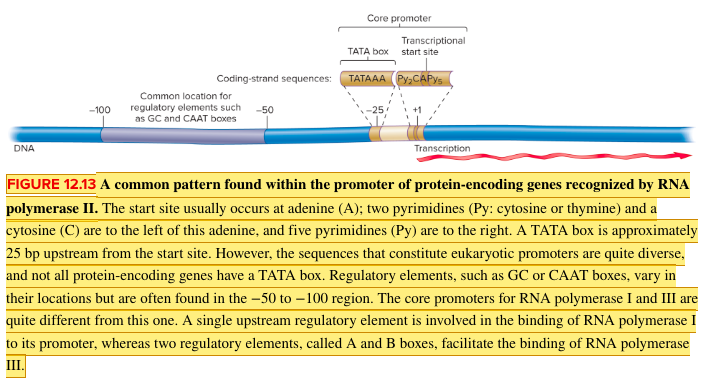
structural; eukaryotes
General transcription factors are those that are ______.
Multiple choice question.
found in both prokaryotic and eukaryotic species
always needed for RNA pol II to initiate transcription
capable of stimulating or inhibiting transcription
always needed for RNA pol II to initiate transcription
What are the two types of regulatory elements that influence the rate of transcription in eukaryotes?
Multiple choice question.
Activators and inhibitors
Mediator-dependent and mediator-independent
Rho-dependent and rho-independent
Enhancers and silencers
Enhancers and silencers
The preinitiation complex is a(n) ______ complex that consists of RNA polymerase II and five general transcription factors.
Multiple choice question.
open complex
closed complex
closed complex
Regulatory elements that stimulate transcription are termed
enhancers
Regulatory elements that inhibit transcription are termed
silencers
In eukaryotic protein-encoding genes, three categories of proteins are required for basal transcription at the core promoter: RNA polymerase ____, general transcription ____, and a complex called mediator.
II; factors
Select all that apply
The basal transcription apparatus consists of what?
Multiple select question.
TFIID, TFIIB, TFIIF, TFIIE, and TFIIH
TATA box plus transcriptional start site
GC and CAAT boxes
RNA polymerase II
Enhancers and silencers
TFIID, TFIIB, TFIIF, TFIIE, and TFIIH
TATA box plus transcriptional start site
RNA polymerase II
For eukaryotic protein-encoding genes, the five proteins that are always needed for RNA polymerase II to initiate RNA synthesis are called ____ ____ factors.
general transcription
In eukaryotes, the protein complex called mediator facilitates the interaction between which of the following?
Multiple choice question.
the newly-synthesized mRNA and the DNA template strand during the elongation phase of transcription
RNA polymerase II and the general transcription factors that bind to the promoter
RNA polymerase II and regulatory transcription factors that bind to enhancers and silencers
RNA polymerase II and the TATAAT sequence of the core promoter
RNA polymerase II and regulatory transcription factors that bind to enhancers and silencers
Which of the following is the very first step in the formation of the preinitiation complex in eukaryotic transcription?
Multiple choice question.
Binding of RNA polymerase II to the TATA box
Binding of TFIID to the TATA box
Binding of TFIID to TFIIB
Binding of RNA polymerase II to TFIIF
Binding of TFIID to the TATA box
An exonuclease binds to the 5'-end of the RNA that is being transcribed and degrades it in the 5' to 3' direction. The exonuclease then catches up to RNA polymerase II and causes termination. This describes the ____ model of transcription termination in eukaryotes.
torpedo
Colinearity refers to the correspondence between ______.
Multiple choice question.
the coding strand and the noncoding strand
the position of a gene on a linear chromosome and when it is expressed
the exons and introns
the coding strand and the polypeptide amino acid sequences
Note: The relationship between the sequence of codons in DNA and the amino acid sequence of a peptide is known as colinearity.
True or false: Introns are intervening sequences that are removed from mRNA and exons are the retained sequences.
True
The combination of five general transcription factors, RNA polymerase II, and a DNA sequence containing a TATA box and a transcriptional start site is called the ______.
Multiple choice question.
mediator
promoter sequence
coding strand sequence
basal transcription apparatus
basal transcription apparatus
In eukaryotes, the interactions between RNA polymerase II and regulatory transcription factors that bind to enhancers and silencers are facilitated by a protein complex called
mediator
RNA splicing is a ______ process that removes ______.
Multiple choice question.
common; exons
common; introns
rare; introns
rare; exons
common; introns
After RNA polymerase II transcribes the polyadenylation signal, it is destabilized and dissociates from the DNA. This describes the ____ model of transcription termination in eukaryotes.
allosteric
Select all that apply
In humans, the long 45S rRNA transcript is cleaved to produce which of the following?
Multiple select question.
30S
15S
28S
11.2S
18S
5.8S
28S
18S
5.8S
The relationship between the sequence of codons in DNA and the amino acid sequence of a peptide is known as
colinearity
The nucleolus in eukaryotes is the site of processing of ______ RNA.
Multiple choice question.
transfer
messenger
ribosomal
small
ribosomal
Sequences that are included in mature mRNA are ____ and sequences that are removed are ____.
exons; introns
An enzyme that cleaves a covalent bond between two nucleotides at one end of a strand is called a(n)
exonuclease
An RNA molecule that has catalytic activity is called a(n)
ribozyme
Note: Ribozymes are catalytically active RNA molecules or RNA–protein complexes, in which solely the RNA provides catalytic activity. The term ribozyme refers to the enzymatic activity and ribonucleic acid nature at the same time. Ribozymes are found in the genomes of species from all kingdoms of life.
The process of removing introns and joining exons together is called RNA
splicing
Note: Removal of introns and joining the exons in a defined order in a transcription unit is called as splicing. Splicing is a modification of the nascent pre-messenger RNA transcript in which introns are removed and exons are joined.
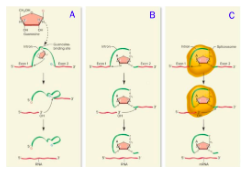
Which of the following panels depict self-splicing introns?
Multiple choice question.
A, B, and C
A only
B only
A and B
C only
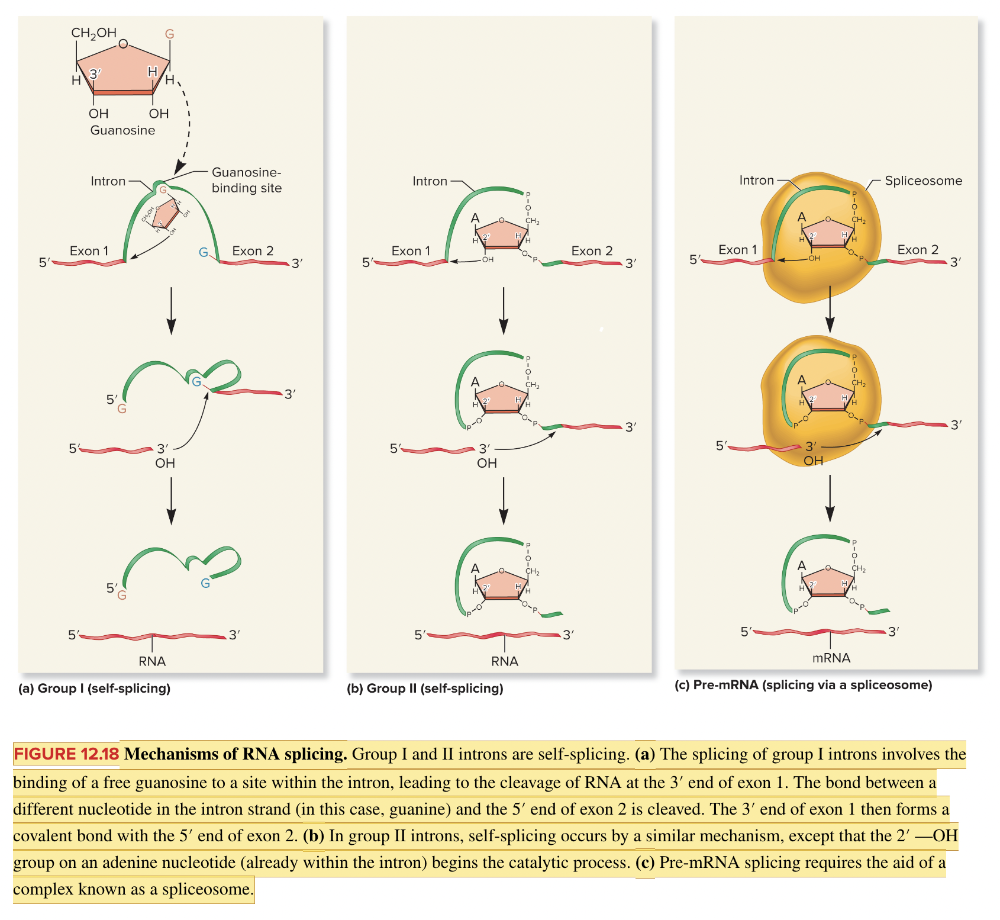
A and B
Note: Figure 12.18 Mechanisms of RNA splicing
In mammals, the ribosomal RNA gene is transcribed by RNA polymerase ____ to make a long primary transcript known as ____ rRNA. This transcript is then cleaved into ____ smaller fragments.
I; 45S; 3
In eukaryotes, the assembly of ribosomal subunits occurs in a site within the nucleus called the
nucleolus
Note: The nucleolus is a ribosome production factory, designed to fulfill the need for large-scale production of rRNAs and assembly of the ribosomal subunits.
The removal of introns where RNA functions as its own ribozyme is a process called ______-splicing.
Multiple choice question.
alternative
complementary
auto
self
self
An enzyme that cleaves a covalent bond between two adjacent nucleotides within a strand is called a(n)
endonuclease
Group I introns undergo a ______ process that is initiated by a(n) ______.
Multiple choice question.
spliceosome-mediated ; U1 molecule binding to the 3' splice site of the intron
self-splicing ; free guanosine outside the intron
spliceosome-mediated ; U1 molecule binding to the 5' splice site of the intron
self-splicing ; adenine found within the intron
self-splicing ; free guanosine outside the intron
Which best describes a ribozyme?
Multiple choice question.
A ribosome that contains many enzymes
An enzyme that digests RNA
An RNA molecule with catalytic activity
An enzyme that is activated upon binding RNA
An RNA molecule with catalytic activity
Group II introns undergo a ______ process that is initiated by a(n) ______.
Multiple choice question.
spliceosome-mediated ; U1 molecule binding to the 5' splice site of the intron
self-splicing ; free guanosine outside the intron
spliceosome-mediated ; U1 molecule binding to the 3' splice site of the intron
self-splicing ; adenine found within the intron
self-splicing ; adenine found within the intron

Match the letter to the correct intron.
A
B
C
Group I intron
Group II intron
Pre-mRNA intron
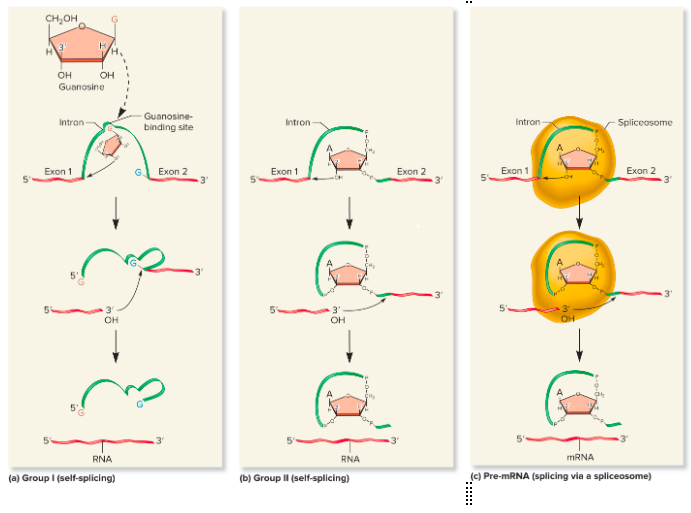
- A Group I intron
- B Group II intron
- C Pre-mRNA intron
Pre-mRNA splicing requires the aid of a multicomponent structure called the
spliceosome
Which of the following statements about splicing in eukaryotes is true?
Multiple choice question.
Both pre-mRNA splicing and self-splicing are very rare.
Both pre-mRNA splicing and self-splicing are widespread phenomena.
Pre-mRNA splicing is a widespread phenomenon, whereas self-splicing is relatively uncommon.
Self-splicing is a widespread phenomenon, whereas pre-mRNA splicing is relatively uncommon.
Pre-mRNA splicing is a widespread phenomenon, whereas self-splicing is relatively uncommon.
Splicing that does not require the aid of other catalysts is known as ____-splicing.
self
A small nuclear ribonucleoprotein (snRNP) consists of small ____ ____ and proteins.
nuclear RNA
Which of the following are self-splicing introns that occur in the rRNA genes of the protist Tetrahymena?
Multiple choice question.
Group II introns
Group I introns
Group III introns
Group I introns
For splicing of pre-mRNA in mammals, the spliceosome recognizes a branch site in the middle of the intron and two sites at the ends of the intron, called the _____ and _____ splice sites.
5'; 3'
The mechanism of self-splicing of group II introns is similar to that of group I introns. The main difference is that a 2'-OH group on a(n) ____ nucleotide within the intron begins the catalytic process.
adenine, A, or adenosine
The metalloribozyme of the spliceosome relies on ______ ions to catalyze removal of introns from ______.
Multiple choice question.
iron; precursor tRNA
iron; pre-mRNA
magnesium; pre-mRNA
magnesium; precursor rRNA
magnesium; pre-mRNA
What is a spliceosome?
Multiple choice question.
A multicomponent structure that removes introns found in pre-mRNA
Another term for the process of alternative splicing
A multicomponent structure that assists in the removal of group I and group II introns
A group of ribosomes that are bound simultaneously to the same mRNA
A multicomponent structure that removes introns found in pre-mRNA
Which of the following can account for different mature transcripts produced from the same pre-mRNA?
Multiple choice question.
5' capping
Self-splicing
Alternative splicing
3' polyadenylation
Reverse transcription
Alternative splicing
True or false: In complex eukaryotes, pre-mRNA splicing is much more common than self-splicing.
True
What are snRNPs?
Multiple choice question.
Components of RNA polymerase II
Proteins that facilitate DNA replication
Components of the spliceosome
Proteins that facilitate 5' capping
Components of the spliceosome
Alternative splicing allows an organism to ______.
Multiple choice question.
transcribe its genes more accurately
repair its genes more efficiently
carry fewer genes in its genome
carry more genes in its genome
carry fewer genes in its genome
Select all that apply
The removal of introns from mammalian pre-mRNA depends upon sequences located at which positions on the intron RNA?
Multiple select question.
adenosine site
guanosine binding site
5' splice site
3' splice site
Lariat formation site
branch site
5' splice site
3' splice site
branch site
The U6 subunit of the spliceosome is called a(n) ______ since its catalytic activity depends upon the presence of Mg2+ ions.
Multiple choice question.
capping enzyme
self-splicing enzyme
polyadenylating enzyme
alternative splicing enzyme
metalloribozyme
metalloribozyme
Exons that are always found in a mature mRNA that are likely to be required for the general structure and function of a protein are ____ exons.
constitutive
The phenomenon whereby different combinations of exons are joined to produce different mRNAs from the same transcript is called ____ ____ (or exon shuffling).
alternative splicing
______ often encodes a portion of a protein that only slightly changes the function of that protein.
Multiple choice question.
A self-splicing intron
A constitutive exon
An alternative intron
An alternative exon
An alternative exon
Select all that apply
In which ways do splicing factors regulate the ability of the spliceosome to choose splice sites?
Multiple select question.
change the mechanism to self-splicing
enhance the ability of the spliceosome to recognize specific splice sites
change the splicing recognition sequence at the intron-exon junctions
act as repressors to inhibit the ability of a spliceosome to recognize a splice site
enhance the ability of the spliceosome to recognize specific splice sites
act as repressors to inhibit the ability of a spliceosome to recognize a splice site
What is the biological advantage of alternative splicing?
Multiple choice question.
Multiple proteins can be derived from a single gene
Multiple pre-mRNAs can be derived from the same gene
Introns are removed more efficiently from the same mRNA
Multiple proteins can be derived from a single gene
Exon-skipping occurs when ______.
Multiple choice question.
an exon is present in a mature mRNA
RNA polymerase skips over an exon during transcription
an exon is not included in a mature mRNA
an intron is included in a mature mRNA
an exon is not included in a mature mRNA
An exon that is required for the general structure and function of a protein is likely to be a(n) ______.
Multiple choice question.
constitutive exon
self-splicing exon
alternative exon
constitutive exon
The capping of a mature mRNA is an event that involves the addition of ______ to its ______.
Multiple choice question.
about 100-200 adenines; 3' end
a 7-methylguanosine; 5' end
a 7-methylguanosine; 3' end
about 100-200 adenines; 5' end
a 7-methylguanosine; 5' end
A portion of an mRNA that is only found in some cell types is a(n) ____ exon.
alternative
Splicing factors can act as _ to inhibit the ability of the spliceosome to recognize a splice site or as _ to increase the ability of the spliceosome to recognize specific splice sites.
repressors; enhancers
The process by which an exon is not included in a mature mRNA is known as exon-
skipping
Select all that apply
The removal of introns from mammalian pre-mRNA depends upon sequences located at which positions on the intron RNA?
Multiple select question.
adenosine site
branch site
5' splice site
Lariat formation site
3' splice site
guanosine binding site
branch site
5' splice site
3' splice site
The addition of a 7-methylguanosine to the 5' end of a mature mRNA is a process known as
capping
The capping of a mature mRNA is a three-step process: (1) the enzyme RNA 5'-____ removes a phosphate; (2) the enzyme ____ attaches guanosine monophosphate (GMP) to the 5' end; and (3) the enzyme _____ attaches a methyl group to a nitrogen at position 7 in the guanine base.
triphosphatase
guanylyltransferase
methyltransferase
Select all that apply
Which of the following are functions of the 7-methylguanosine cap of eukaryotic mRNAs?
Multiple select question.
Efficient splicing of introns, particularly the most 5' intron
Recognition of the transcript by translation initiation factors
Synthesis of the polyA tail at the 3' end
Aggregation site for proteins involved in RNA editing
Exit of most mRNAs from the nucleus into the cytoplasm
Efficient splicing of introns, particularly the most 5' intron
Recognition of the transcript by translation initiation factors
Exit of most mRNAs from the nucleus into the cytoplasm
The processing that occurs at the 3' end of eukaryotic mRNAs is known as ______.
Multiple choice question.
polyadenylation
self-splicing
alternative splicing
capping
polyadenylation
Exon-skipping occurs when ______.
Multiple choice question.
an exon is not included in a mature mRNA
an intron is included in a mature mRNA
RNA polymerase skips over an exon during transcription
an exon is present in a mature mRNA
an exon is not included in a mature mRNA

This figure depicts the ______.
Multiple choice question.
3' splice site of the intron
5' splice site of the intron
5' capping signal sequence
3' polyadenylation signal sequence
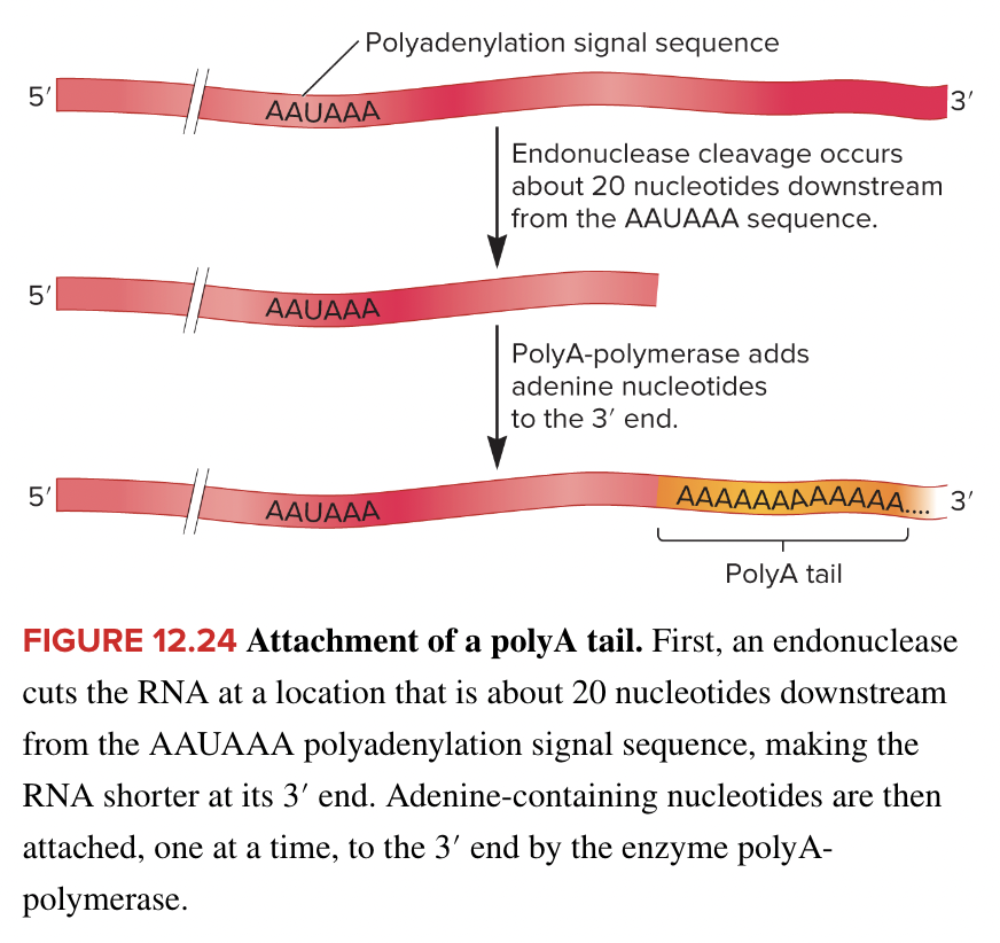
3' polyadenylation signal sequence
Place the steps of mRNA capping in order, starting with the earliest on top.
Methyltransferase attaches a methyl group to the guanine base
RNA 5'-triphosphatase removes one of the three phosphates
Guanyltransferase attaches GMP to the 5' end

1. RNA 5'-triphosphatase
2. Guanyltransferase
3. Methyltransferase
In some cases, an mRNA molecule can be subjected to addition or deletion or conversion of bases, after transcription. This phenomenon is best described as RNA ______.
Multiple choice question.
splicing
modification
processing
editing
capping
editing
Multiple Choice Question
The 7-methylguanosine cap of eukaryotic mRNAs serves which of the following functions?
Multiple choice question.
Synthesis of the polyA tail at the 3' end
Recognition of the 5' end of the transcript by the translation machinery
Transport of mRNAs into the nucleus
Blocking the splicing machinery which may render the mRNA nonfunctional
Recognition of the 5' end of the transcript by the translation machinery
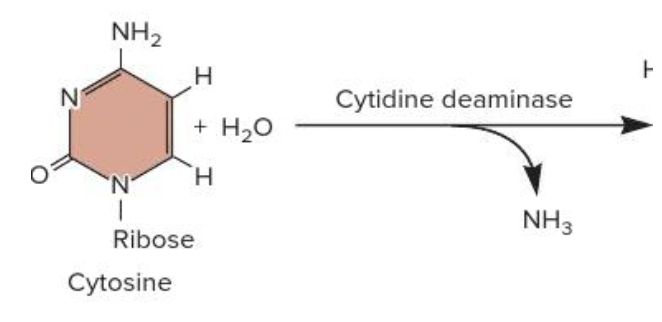
What is produced by this reaction?
Multiple choice question.
Uracil
Thymine
Guanine
Inosine
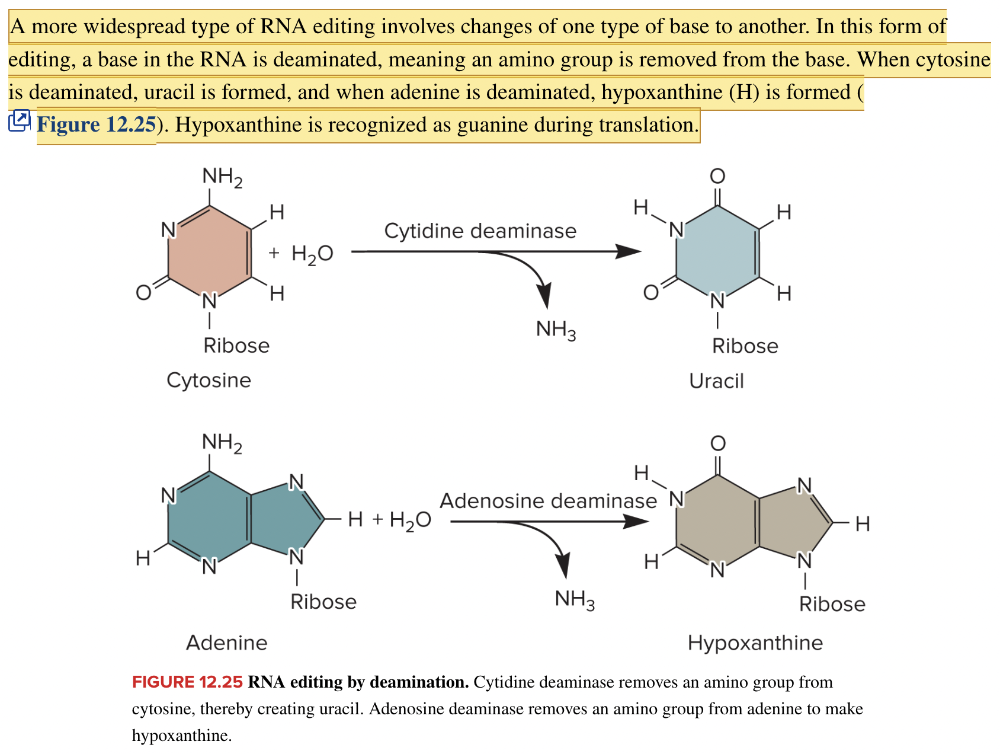
Uracil
The enzymatic addition of about 250 adenine nucleotides to the mRNA after it is transcribed is a process called
polyadenylation
Which one is not a characteristic of bacterial transcription?
Multiple choice question.
Termination can be rho-dependent or rho-independent
mRNA can be modified by RNA editing
Presence of a single RNA polymerase
mRNA can be degraded after addition of a 3' polyA tail
Promoter consists of a -35 and -10 sequence
mRNA can be modified by RNA editing
At the ribosome, tRNA anticodons recognize mRNA codons to produce a protein through the process of ______.
Multiple choice question.
translation
duplication
replication
transcription
translation
The polyadenylation signal sequence in eukaryotic mRNA is ______.
Multiple choice question.
5' AAUAAA 3'
5' AAAUUU 3'
5' TATAAAA 3'
5' TTGACAA 3'
5' AAUAAA 3'
When a protein-encoding gene is transcribed, the product is called _____ RNA.
messenger or m
The process by which the nucleotide sequence of a mRNA molecule is changed after it has been transcribed is called ____ ____.
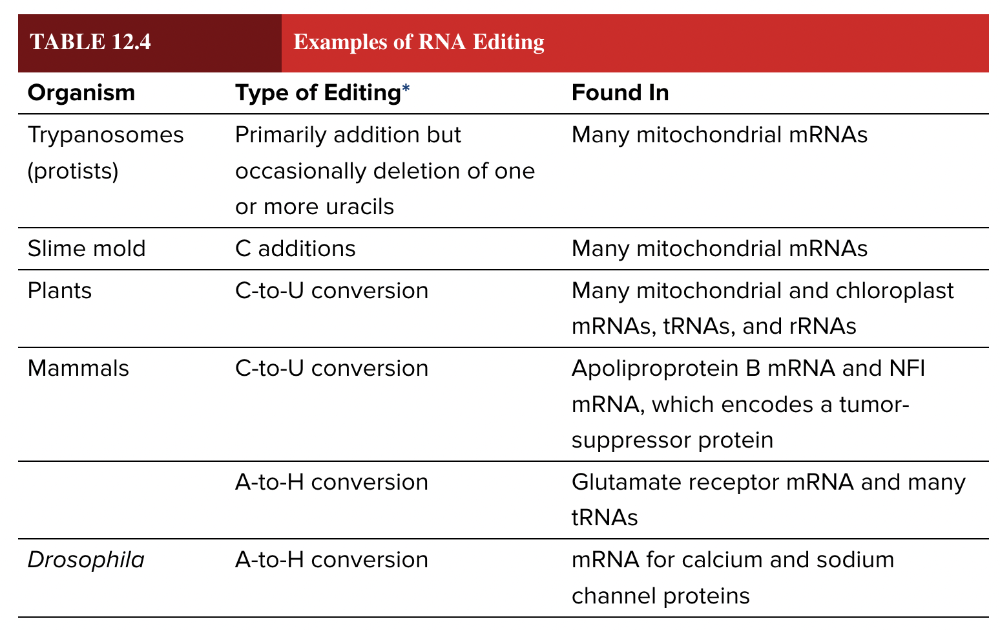
RNA editing
Providing the information to produce suitable amounts of a protein appropriate to a specific cell type is the function of the ____ material.
genetic
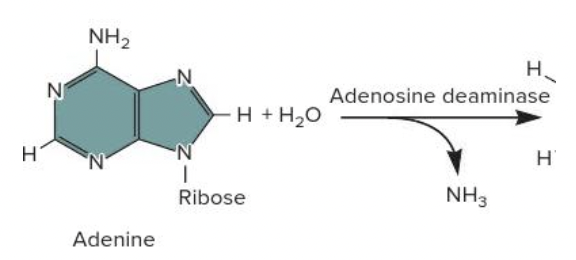
The product of this reaction is

hypoxanthine or inosine
To explain why patients had a buildup of the urine-darkening metabolite homogentisic acid, Archibald Garrod proposed that they were lacking ______.
Multiple choice question.
mitochondria
an enzyme that would metabolize homogentisic acid
receptors for homogentisic acid
ribosomes to make metabolic enzymes
an enzyme that would metabolize homogentisic acid
Select all that apply
Which of the following are features of transcription in eukaryotes only?
Multiple select question.
Presence of three types of RNA polymerases
Mediator controls the switch to the elongation phase
Termination occurs according to the allosteric or torpedo model
Addition of 7-methylguanosine cap
The promoter consists of a -35 and a -10 sequence
Presence of three types of RNA polymerases
Mediator controls the switch to the elongation phase
Termination occurs according to the allosteric or torpedo model
Addition of 7-methylguanosine cap
The synthesis of a protein using the sequence of codons in a messenger RNA is called
translation
Garrod was the first to suggest that there is a relationship between ____ and the production of proteins.
genes
Note: Garrod's proposition, attributing a defective enzyme to a defective gene, was the first ever to suggest a direct link between genes and proteins.
Which type of RNA is transcribed from a protein-encoding gene?
Multiple choice question.
messenger RNA
transfer RNA
ribosomal RNA
messenger RNA
In which organism did Beadle and Tatum conduct their experiments?
Multiple choice question.
Escherichia coli
Neurospora crassa
Mus musculus
Saccharomyces cerevisiae
Neurospora crassa
Note: Beadle and Tatum worked with a simple organism: common bread mold, or Neurospora crassa. Using Neurospora, they were able to show a clear connection between genes and metabolic enzymes.
Select all that apply
Which represent the function(s) of the genetic material?
Multiple select question.
Ensuring that a protein is produced at the proper time in the cycle of the cell or life cycle of the organism.
Carrying out metabolic reactions appropriate to a specific cell type.
Ensuring that a protein is produced in sufficient amounts for effective cellular functions.
Coordinating the assembly of cellular organelles.
Encoding the production of a protein in a specific cell type.
Ensuring that a protein is produced at the proper time in the cycle of the cell or life cycle of the organism.
Ensuring that a protein is produced in sufficient amounts for effective cellular functions.
Encoding the production of a protein in a specific cell type.
In experiments where Beadle and Tatum were able to determine the steps in a biochemical pathway, they concluded that the synthesis of a single enzyme was controlled by a ______
Multiple choice question.
Second
single chromosome
single gene
single enzyme
single gene
Archibald Garrod proposed that the buildup of homogentisic acid leading to the symptoms of alkaptonuria resulted from a missing
enzyme
Select all that apply
Select ways in which the one-gene/one-enzyme hypothesis had to be modified from its original form.
Multiple select question.
All proteins, including enzymes as well as other types of proteins, are encoded by genes.
Some genes encode functional RNA molecules rather than polypeptides.
Alternative splicing and RNA editing can produce more than one polypeptide from a single gene.
One gene encodes one protein, which may be made up of many different polypeptide chains.
All proteins, including enzymes as well as other types of proteins, are encoded by genes.
Some genes encode functional RNA molecules rather than polypeptides.
Alternative splicing and RNA editing can produce more than one polypeptide from a single gene.
The bacterial RNA polymerase core enzyme is composed of five different polypeptide chains. The number of genes needed to code for this enzyme is ____. Assume alternative splicing is not used here.
5
Which scientist(s) was/were the first to propose a relationship between genes and the production of proteins?
Multiple choice question.
Garrod
Beadle & Tatum
Nirenberg & Matthaei
Watson & Crick
Garrod
Beadle and Tatum designed experiments to test how ____ required for the biosynthesis of methionine are controlled by genes.
enzymes
A protein can be made of more than one
polypeptide
Note: This forms the primary structure of a long polypeptide chain. Proteins are made up of one or several polypeptides that have interacted together to form the final, stable, working conformation. Amino acids can either be α-amino acids are β-amino acids.
In experiments where Beadle and Tatum were able to deduce the steps in a biochemical pathway, they concluded that a single gene controlled the synthesis of a ______ ______.
Multiple choice question.
single carbohydrate
single gene
single chromosome
single enzyme
Second
single enzyme
Which one is a product of transcription that does not encode a protein, such as a transfer RNA or a ribosomal RNA?
Multiple choice question.
functional RNA molecule
translational RNA molecule
non-genic sequence
functional RNA molecule
Select all that apply
Select all types of new information that led to modification of the original one-gene/one-enzyme hypothesis.
Multiple select question.
One gene can be used to make more than one polypeptide.
Many genes can affect the same phenotypic trait.
Some proteins are made of more than one type of polypeptide.
Enzymes are not the only protein products of genes.
One gene can affect more than one phenotypic trait.
Some genes code for functional RNA products.
One gene can be used to make more than one polypeptide.
Some proteins are made of more than one type of polypeptide.
Enzymes are not the only protein products of genes.
Some genes code for functional RNA products.
Select all that apply
One stretch of genomic DNA can lead to the production of more than one polypeptide due to ______.
Multiple select question.
alternative splicing of introns
RNA editing
transcription of different portions of the DNA sequence
translation of different portions of the mRNA
alternative splicing of introns
RNA editing
Suppose there is an enzyme that is made of two different polypeptide chains. How many genes are needed to code for this enzyme? Assume alternative splicing is not used here.
Multiple choice question.
One gene because there is only one enzyme.
Four genes, because there are active and inactive forms of each polypeptide chain.
Two genes, one for each polypeptide chain.
Two genes, one for each polypeptide chain.
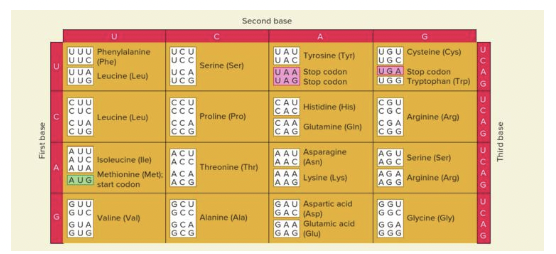
Which amino acid will be carried by a tRNA with the following anticodon: 3'-GUA-5'?
Multiple choice question.
Tyrosine
Valine
Histidine
Methionine
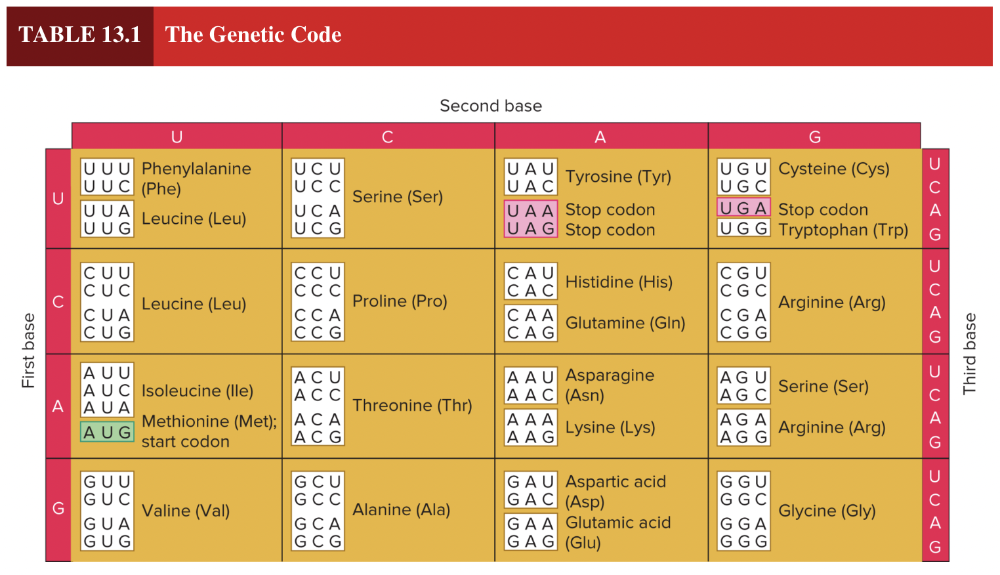
Histidine
A set of three-letter combinations of nucleotides called codons, each of which corresponds to a specific amino acid, represents the
genetic code
Which of the following is correct?
Multiple choice question.
A polypeptide can be made of more than one protein.
All polypeptides are only made of one protein.
A protein can be made of more than one polypeptide.
All proteins are only made of one polypeptide.
A protein can be made of more than one polypeptide.
If a gene's transcript is not used to build a polypeptide, it may encode a ____ ____ molecule.
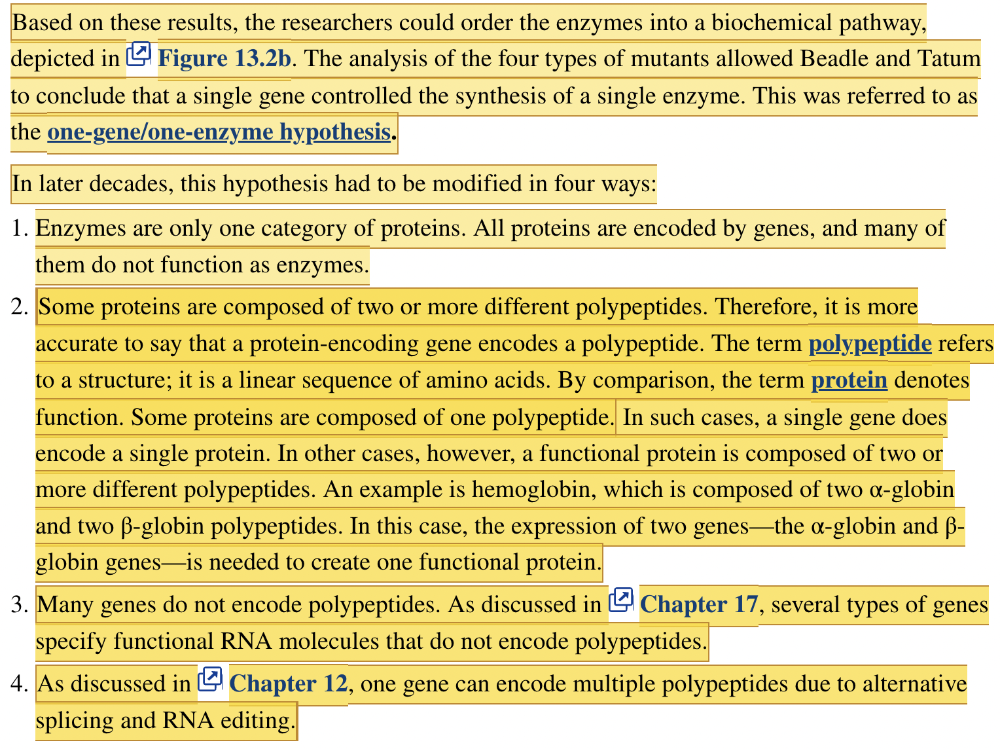
functional RNA
Alternative splicing and RNA editing are mechanisms that allow ______.
Multiple choice question.
several genes to produce one polypeptide
several genes to produce the same mRNA
several different mRNAs to produce the same polypeptide
one gene to produce several different polypeptides
one gene to produce several different polypeptides
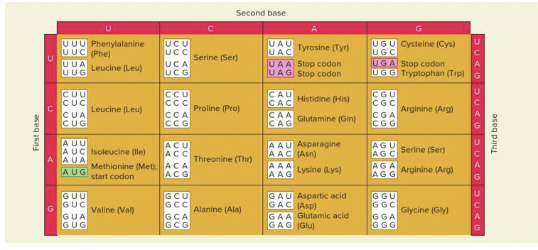
If tryptophan is amino acid #67 in a particular protein, what is the anticodon of the transfer RNA that delivered tryptophan to this location?
Multiple choice question.
3'-ACC-5'
5'-GGU-3'
5'-UGG-3'
3'-CCA-5'

3'-ACC-5'
Arranging the four RNA nucleotides A, G, C and U in groups of three with all possible combinations leads to a set of codons called the ______.
Multiple choice question.
transfer RNA sequence
genetic code
gene sequence
ribosomal RNA sequence
amino acid sequence
genetic code
Which type of codon would lead to the placement of a specific amino acid such as leucine into the polypeptide sequence?
Multiple choice question.
Nonsense codon
Start codon
Sense codon
Stop codon
Sense codon
Select all that apply
What other names refer to stop codons?
Multiple select question.
Start codons
Sense codons
Termination codons
Nonsense codons
Termination codons
Nonsense codons
A series of three nucleotide bases that specifies the placement of the amino acid methionine at the beginning of a polypeptide chain is a ______ codon.
Multiple choice question.
nonsense
synonymous
start
stop
start
A series of three nucleotide bases that specifies the insertion of a particular amino acid into a polypeptide chain is a ____ ____.
sense codon
A series of three nucleotide bases that signals the end of a polypeptide chain is a(n) ______ codon.
Multiple choice question.
synonymous
start
sense
stop
antisense
stop
The codon AUG can act as a start codon or as a _____ codon to specify the placement of additional methionines in a polypeptide.
Multiple choice question.
synonymous codon
stop codon
nonsense codon
termination codon
sense codon
sense codon
To bring a specific amino acid into its location on a polypeptide chain, which sequence on transfer RNA must bind to messenger RNA?
Multiple choice question.
5' sequence
Anticodon
Codon
3' sequence
Anticodon
A sequence of bases that begins with the start codon and continues to the end of the coding sequence by reading the bases in groups of three is called the ____ ____.
genetic code
several different mRNAs to produce the same polypeptide
several genes to produce one polypeptide
several genes to produce the same mRNA
one gene to produce several different polypeptides
one gene to produce several different polypeptides
The genetic code is described as universal, yet exceptions to the rules exist. How widespread are these exceptions?
Multiple choice question.
At least 20 codon differences exist for eukaryotes such as yeast and ciliated protozoans
The genetic code of a mitochondrion has completely unique codons
A few codon differences exist, particularly within mitochondria
A few codon differences exist, particularly within mitochondria
An AUG codon, which specifies the amino acid methionine and is often the first codon that begins a polypeptide sequence, is called a(n) codon.
start
Selenocysteine and pyrrolysine are encoded by codons that usually function as ______.
Multiple choice question.
cysteine and lysine codons
anticodons
start codons
stop codons
stop codons
The signal for termination of translation is called a(n) ____ codon.
stop, nonsense, termination, terminator, or terminal
Which type of bond is formed between the carboxyl group of one amino acid and the amino group of the next amino acid?
Multiple choice question.
ionic bond
phosphodiester bond
peptide bond
hydrogen bond
peptide bond
A series of three nucleotides in transfer RNA that is complementary to a codon in messenger RNA is called a(n)
anticodon
Suppose methionine is located at the amino-terminus of a specific protein. The codon for methionine would be located closest to which portion of the corresponding mRNA?
Multiple choice question.
The 5' end of the mRNA
The 3' end of the mRNA.
The middle of the mRNA
The 5' end of the mRNA
Beginning with the start codon and reading the following bases in groups of three determines the ______.
Multiple choice question.
reading frame
promoter sequence
transcript
untranslated region
reading frame
Where is the first amino acid in a polypeptide chain is located?
Multiple choice question.
amino-terminus
R-terminus
central-terminus
carboxyl-terminus
amino-terminus
UGA is a stop codon for messenger RNAs translated in the cytoplasm of eukaryotic cells but is a codon for tryptophan in that cell’s mitochondria. What is the explanation for this phenomenon?
Multiple choice question.
There are no stop codons used during protein synthesis in mitochondria
None of the codons used in mitochondria are similar to the codons used by the surrounding cell
Codons used in mitochondria show a few exceptions to the universal genetic code
Proteins made in the surrounding cell do not contain tryptophan
Codons used in mitochondria show a few exceptions to the universal genetic code
The amino acids that are sometimes referred to as the twenty-first and twenty-second amino acids are called ____ and ____.
selenocysteine or Sec
pyrrolysine or Pyl
Where is the last amino acid in a polypeptide chain is located?
Multiple choice question.
amino-terminus
R-terminus
central-terminus
carboxyl-terminus
carboxyl-terminus
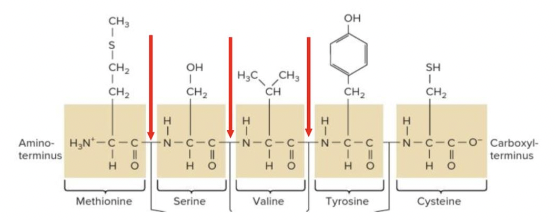
What is the name for the type of bond that joins the amino acids as shown by the arrows in the diagram?
Multiple choice question.
Peptide bond
Ionic bond
Hydrogen bond
Phosphodiester bond
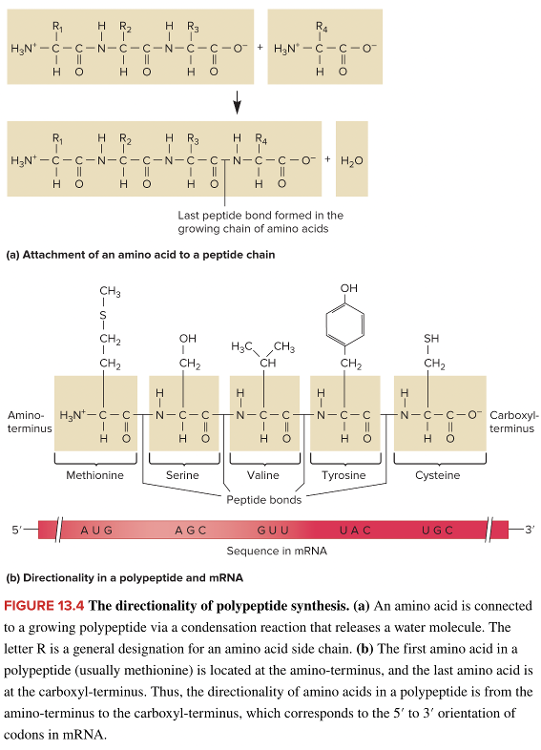
Peptide bond
What is the name for the chemical group that is unique for each of the 20 amino acids?
Multiple choice question.
R group
carboxylic acid group
central carbon
amino group
R group
The codon for the amino acid found at the carboxyl-terminus of a polypeptide is located closest to the ____ end of the corresponding mRNA.
3'
When a polypeptide is synthesized, the first amino acid to be put in place is located at the ______-______.
Multiple choice question.
carboxyl- or C-terminus
amino- or N-terminus
amino- or N-terminus
Which type of R group is consistent with an amino acid that is found in the interior of a folded protein?
Multiple choice question.
Hydrophilic
Neither hydrophobic nor hydrophilic
Hydrophobic
Both hydrophobic and hydrophilic
Hydrophobic
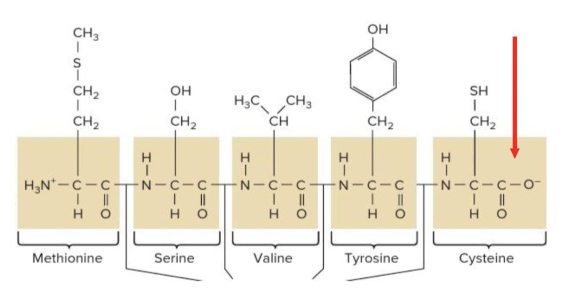
The position on the polypeptide chain indicated by the arrow in the diagram is the ______.
Multiple choice question.
amino-terminus
3'-end
carboxyl-terminus
stop codon
start codon
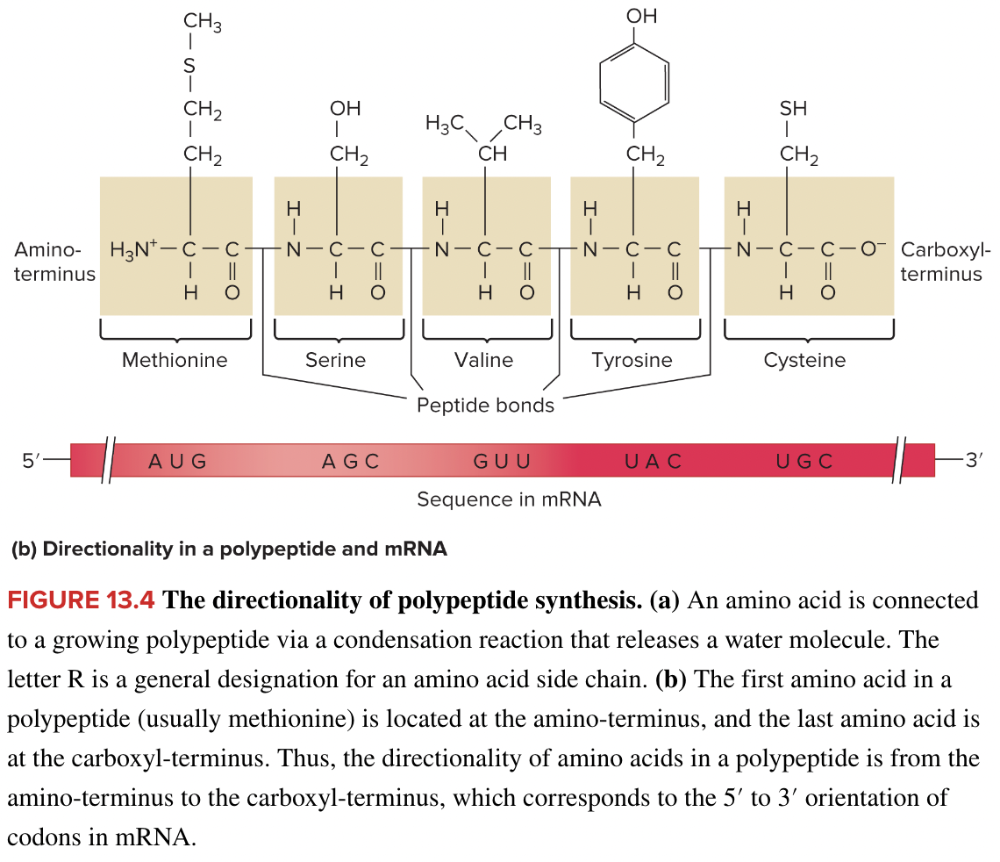
carboxyl-terminus
The sequence of amino acids that results from gene transcription and mRNA translation represents which structure of the protein?
Multiple choice question.
Secondary structure
Primary structure
Tertiary structure
Quaternary structure
Primary structure
Which group gives an amino acid its unique chemical properties?
Multiple choice question.
amino group
central carbon
R group
carboxylic acid group
R group
What dictates the pattern of folding of a protein?
Multiple choice question.
The number of polypeptide chains that associate with each other
The number of ionic bonds occurring in the secondary structure
The chemical features of the R groups in the primary sequence
The chemical features of the R groups in the primary sequence
A protein that assists with the proper folding of other polypeptides is a(n)
chaperone
Where is the first amino acid in a polypeptide chain is located?
Multiple choice question.
carboxyl-terminus
R-terminus
amino-terminus
central-terminus
amino-terminus
Which type of R group is consistent with an amino acid that is found on the exterior of a folded protein?
Multiple choice question.
Both hydrophilic and hydrophobic
Hydrophobic
Neither hydrophilic nor hydrophobic
Hydrophilic
Hydrophilic
The initial folding of a polypeptide into a regular repeating shape represents its ____ structure.
secondary
The consecutive order of amino acids in a polypeptide chain represents its ____ structure.
primary
The folded-three dimensional conformation of a polypeptide represents its ____ structure.
tertiary
Suppose you are comparing two cellular proteins that have different three-dimensional shapes. What is the determining factor that led to those differences?
Multiple choice question.
The two proteins were synthesized at different speeds.
The two proteins have the same R groups, but different N groups.
The two proteins have different amino acid sequences.
The two proteins were produced by different ribosomes.
Correct Answer
The two proteins have different amino acid sequences.
The two proteins have different amino acid sequences.
Proper folding of some polypeptides requires the assistance of a(n) ______.
Multiple choice question.
ribosome
enzyme
transfer RNA
chaperone
chaperone
The oxygen-carrying molecule hemoglobin is an association of four polypeptides, two called α-hemoglobin and two called β-hemoglobin. The level of protein structure demonstrated by hemoglobin is ______ structure.
Multiple choice question.
quaternary
primary
secondary
tertiary
quaternary
When a polypeptide is synthesized, the first amino acid to be put in place is located at the ______-______.
Multiple choice question.
amino- or N-terminus
carboxyl- or C-terminus
amino- or N-terminus
Which level of protein structure is represented by the association of multiple polypeptide subunits?
Multiple choice question.
Quaternary structure
Primary structure
Tertiary structure
Secondary structure
Quaternary structure
The protein structure stabilized by the formation of hydrogen bonds between atoms found in the polypeptide backbone is ______ structure.
Multiple choice question.
quaternary
primary
tertiary
secondary
secondary
The folding of α helical regions and beta-sheet regions relative to each other leads to formation of a polypeptide's ______ structure.
Multiple choice question.
primary
tertiary
quaternary
secondary
tertiary
Cells of the pancreas secrete the hormone insulin to assist with glucose uptake while neurons release neurotransmitters to conduct nerve signals. The difference in products released by these two types of cells depends on differences in ______.
Multiple choice question.
DNA content between the two types of cells
the types of proteins produced within each cell
the genetic code between the two types of cells
differences in the structure of ribosomes found in each type of cell
the types of proteins produced within each cell
To determine the codons of the genetic code, scientists added mRNA and amino acids to an extract from bacterial cells containing ribosomes and tRNAs that was called a ____-____ ____ system.
cell-free translation
For a protein, an association of two or more polypeptide chains represents its ____ structure.
quaternary
Note: Quaternary structure exists in proteins consisting of two or more identical or different polypeptide chains (subunits). These proteins are called oligomers because they have two or more subunits. The quaternary structure describes the manner in which subunits are arranged in the native protein.
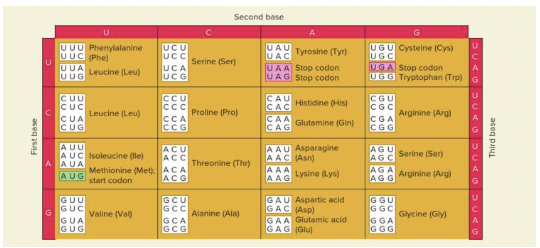
Select all that apply
If a cell-free translation were carried out with synthetic mRNAs produced from a mixture of 25% G and 75% A, which amino acids would be incorporated into the resulting polypeptides?
Multiple select question.
Glutamine
Serine
Glutamic acid
Glycine
Lysine
Arginine

Glutamic acid
Glycine
Lysine
Arginine
For a protein with quaternary structure, the individual polypeptides are called ____ of the protein.
subunits

If synthetic mRNAs are made with a mixture of 60% C and 40% U, what is the predicted percentage of proline among the amino acids in the polypeptides produced from these synthetic mRNAs?
Multiple choice question.
21.6%
24%
36%
14.4%
16%

36%
36% Explanation – Since, the mixture for synthetic mRNA contains 60% C and 40% U. Thus, Frequency of C in synthetic mRNA will be = 60/100 = 0.6 Frequency of U in synthetic mRNA will be = 40/100 = 0.4 Frequency of different possible combinations
Suppose a mixture of 40% C and 60% A was used to produce synthetic mRNAs, and the percentage of asparagine among the amino acids in the resulting polypeptides was 14.4%. This suggests that the codon for asparagine has ______.
Multiple choice question.
two Cs and one A
three Cs
two As and one C
three As
two As and one C
Properties such as cell shape and organization and cellular movement depend upon the direct action of which type of cellular component?
Multiple choice question.
Carbohydrates
Lipids
Nucleic Acids
Proteins
Proteins
To decipher the genetic code, scientists were able to synthesize radioactively-labeled polypeptides from synthetic messenger RNAs in a ______ system.
Multiple choice question.
ribosome-free translation
cell-free translation
tRNA-free translation
cell-free transcription
cell-free translation
In experiments designed to "crack" the genetic code, a cell-free translation system was used to produce ______ when ______ were added.
Multiple choice question.
polypeptides; mRNA and amino acids
messenger RNA; ribonucleotides
ribosomes; RNA and proteins
tRNAs; amino acids
polypeptides; mRNA and amino acids

Select all that apply
If a cell-free translation were carried out with synthetic mRNAs produced from a mixture of 25% A and 75% C, which amino acids would be incorporated into the resulting polypeptides?
Multiple select question.
Asparagine
Threonine
Glutamic acid
Histidine
Proline
Aspartic acid
Lysine
Glutamine

Asparagine
Threonine
Histidine
Proline
Lysine
Glutamine
Select all that apply
Which of the following were used in the efforts to decipher the genetic code?
Multiple select question.
Triplet-binding assays to determine which transfer RNAs bind to specific codons
Cell-free translation experiments using synthetic messenger RNAs
In vitro transcription assays to show which types of mRNA are produced
Cell-free translation experiments using RNA copolymers with repeating patterns of nucleotides
Triplet-binding assays to determine which transfer RNAs bind to specific codons
Cell-free translation experiments using synthetic messenger RNAs
Cell-free translation experiments using RNA copolymers with repeating patterns of nucleotides
If synthetic mRNAs are made with a mixture of 60% C and 40% U, what is the predicted percentage of phenylalanine among the amino acids in the polypeptides produced from these synthetic mRNAs?
Multiple choice question.
9.6%
6.4%
24%
36%
16%
16%
Suppose a mixture of 40% C and 60% A was used to produce synthetic mRNAs, and the percentage of histidine among the amino acids in the resulting polypeptides was 9.6%. This suggests that the codon for histidine has ______.
Multiple choice question.
two Cs and one A
three As
two As and one C
three Cs
two Cs and one A
To decipher the genetic code, a cell-free translation system containing ribosomes, tRNAs, enzymes and radioactive amino acids was used to ______.
Multiple choice question.
synthesize prokaryotic DNA from RNA
directly observe codon-anticodon binding
synthesize radioactively-labeled polypeptides from synthetic messenger RNAs
synthesize messenger RNAs from prokaryotic DNA
synthesize radioactively-labeled polypeptides in the absence of mRNA
synthesize radioactively-labeled polypeptides from synthetic messenger RNAs
To account for the involvement of RNA molecules for incorporating amino acids into a protein chain, Francis Crick proposed the ______ hypothesis.
Multiple choice question.
genetic code
wobble
base-pairing
adaptor
adaptor

Which amino acid is carried by a transfer RNA with an anticodon sequence of 3'-GCA-5'?
Multiple choice question.
Cysteine
Alanine
Arginine
Threonine

Arginine
In addition to cell-free translation experiments with mixtures of synthetic RNAs, efforts to decipher the genetic code included ______.
Multiple choice question.
cell-free translation of copolymers and triplet-binding assays
transcription assays and cell-free translation of copolymers
DNA-RNA binding assays and triplet-binding assays
cell-free translation of copolymers and triplet-binding assays
Which nucleotide in a tRNA anticodon would bind to the A nucleotide in an mRNA codon?
Multiple choice question.
G
U
C
T
A
U
Which of the following represent common structural features of transfer RNA molecules?
Multiple select question.
Anticodon sequence
Codon sequence to specify which amino acid will bind
Amino acid acceptor stem with a 3' single-stranded region
A small number of variable sites
Three stem-loops
Anticodon sequence
Amino acid acceptor stem with a 3' single-stranded region
A small number of variable sites
Three stem-loops
Suppose a mixture of 40% C and 60% A was used to produce synthetic mRNAs, and the percentage of asparagine among the amino acids in the resulting polypeptides was 14.4%. This suggests that the codon for asparagine has ______.
Multiple choice question.
two Cs and one A
two As and one C
three Cs
three As
two As and one C
Francis Crick proposed that certain types of RNA molecules were involved in the incorporation of amino acids into a polypeptide chain in the ____ hypothesis.
adaptor
The single-stranded region at the 3' end of a transfer RNA is the location where a(n) ______ becomes attached.
Multiple choice question.
carboxyl group
hydroxyl group
poly-A tail
7-methyl guanosine cap
amino acid
amino acid

Which amino acid is carried by a transfer RNA with an anticodon sequence of 3'-CGA-5'?
Multiple choice question.
Serine
Alanine
Arginine
Cysteine

Alanine
Which nucleotide in a tRNA anticodon would bind to the U nucleotide in an mRNA codon?
Multiple choice question.
G
C
A
T
U
A
The function of an aminoacyl-tRNA synthetase enzyme is to catalyze the ______.
Multiple choice question.
synthesis of tRNA
binding of a tRNA anticodon to a mRNA codon
attachment of an amino acid to its appropriate tRNA
addition of amino acids to a growing polypeptide chain
addition of a single-stranded sequence to the 3' end of the tRNA
attachment of an amino acid to its appropriate tRNA
Which type of RNA is shown in the figure?
Multiple choice question.
Messenger RNA
Transfer RNA
Ribosomal RNA
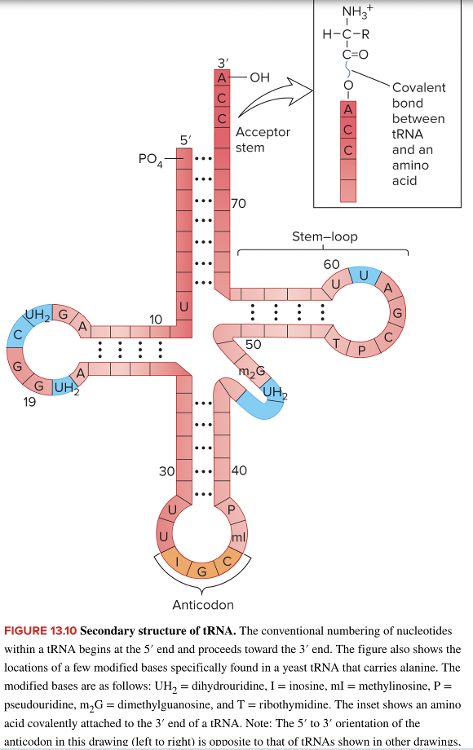
Transfer RNA
Select all that apply
Which of the following must bind to an aminoacyl-tRNA synthetase enzyme in order to charge a transfer RNA?
Multiple select question.
ATP
An mRNA codon
A specific amino acid
A specific transfer RNA
Pyrophosphate
A ribosome
ATP
A specific amino acid
A specific transfer RNA
The location on a transfer RNA where an amino acid becomes attached is the ______.
Multiple choice question.
5' end with a double-stranded region
variable site
acceptor stem with a 3' single-stranded region
stem-loop structure
anticodon
acceptor stem with a 3' single-stranded region
Which enzyme catalyzes the attachment of a specific amino acid to the correct tRNA?
Multiple choice question.
Transfer RNA nucleotidyltransferase
Amino acid transferase
Aminoacyl-tRNA synthetase
Peptidyl transferase
RNA polymerase
Aminoacyl-tRNA synthetase
A transfer RNA that has an amino acid attached to its 3' end is called a(n) ____ ____.
aminoacyl tRNA
In order to charge a tRNA, ATP, a specific transfer RNA and a specific amino acid all bind to which enzyme?
Multiple choice question.
RNA polymerase
Amino acid synthetase
ATP synthase
Aminoacyl-tRNA synthetase
Peptidyl-transferase
Aminoacyl-tRNA synthetase
Select all that apply
Chemically-modified bases in transfer RNA molecules can affect ______.
Multiple select question.
codon-anticodon recognition
peptide chain termination
translation rate
recognition of tRNAs by aminoacyl-tRNA synthetases
transcription rate
codon-anticodon recognition
translation rate
recognition of tRNAs by aminoacyl-tRNA synthetases
Codons UUC and UUU lead to the placement of phenylalanine at a specific position in the protein chain. This type of mismatch in codon-anticodon binding that can occur at the third base of the codon is called
wobble
The single-stranded region at the 3' end of a transfer RNA is the location where a(n) ______ becomes attached.
Multiple choice question.
7-methyl guanosine cap
amino acid
hydroxyl group
poly-A tail
carboxyl group
amino acid
The complex of rRNA and protein that acts as the site of translation is the
ribosome
Note: As previously mentioned, ribosomes are the specialized cellular structures in which translation takes place. This means that ribosomes are the sites at which the genetic code is actually read by a cell. Ribosomes are themselves composed of a complex of proteins and specialized RNA molecules called ribosomal RNA (rRNA).
Both eukaryotic and prokaryotic cells have ribosomes in the
cytosol, cytoplasm, or cytosolic
An aminoacyl-tRNA is a transfer RNA ______.
Multiple choice question.
that is ready to pick up an amino acid
with an amino acid attached to its 3' end
that has delivered its amino acid to a growing peptide chain
with an amino acid attached to its 5' end
with an amino acid attached to its 3' end
Select all that apply
In eukaryotic cells, where can ribosomes be found?
Multiple select question.
In chloroplasts
Embedded in the plasma membrane
In mitochondria
In the Golgi apparatus
In the cytosol
In chloroplasts
In mitochondria
In the cytosol
Which positions of tRNA molecules contain the largest variety of modified nucleotides?
Multiple choice question.
19 and 60
1 and 70
34 and 37
12 and 47
34 and 37
According to the wobble rules, which base of the codon can be mismatched with an anticodon base on the tRNA?
Multiple choice question.
Third base of the codon
Any of the three bases of the codon
First base of the codon
Second base of the codon
None of the three bases of the codon
Third base of the codon
Select all that apply
Which components are assembled into the subunits of a ribosome?
Multiple select question.
Transfer RNA
Ribosomal RNA
Messenger RNA
Ribosomal proteins
Ribosomal RNA
Ribosomal proteins
Translation takes place on a structure called the
ribosome
Note: Translation occurs in a structure called the ribosome, which is a factory for the synthesis of proteins. The ribosome has a small and a large subunit and is a complex molecule composed of several ribosomal RNA molecules and a number of proteins.
In eukaryotic cells, the ______ is the site of ribosomal subunit assembly, using ______ from the cytosol and ______ from the nucleus.
Multiple choice question.
nucleolus, rRNA, proteins
cytosol, rRNA, proteins
nucleolus, proteins, rRNA
nucleolus, proteins, mRNA
cytosol, proteins, rRNA
nucleolus, proteins, rRNA
In which cellular location would ribosomes be found for both prokaryotic and eukaryotic cells?
Multiple choice question.
Mitochondria
Chloroplasts
Mitochondria and chloroplasts
Cytosol, mitochondria and chloroplasts
Cytosol
Cytosol
A plant cell will have ribosomes in its ______.
Multiple choice question.
cytosol only
cytosol and chloroplasts only
cytosol, mitochondria and chloroplasts
mitochondria only
chloroplasts only
cytosol, mitochondria and chloroplasts
A polyribosome is ______.
Multiple choice question.
many ribosomes bound to transfer RNAs
many messenger RNAs bound to the same two ribosomal subunits
a messenger RNA transcript that has many bound ribosomes in the act of translation
a ribosome with three or more subunits
a messenger RNA bound to a ribosome with three or more subunits
a messenger RNA transcript that has many bound ribosomes in the act of translation
Select all that apply
Chemically-modified bases in transfer RNA molecules can affect ______.
Multiple select question.
translation rate
codon-anticodon recognition
peptide chain termination
recognition of tRNAs by aminoacyl-tRNA synthetases
transcription rate
translation rate
codon-anticodon recognition
recognition of tRNAs by aminoacyl-tRNA synthetases
Each ribosomal subunit is assembled from ribosomal RNA and many different
proteins
Note: Each subunit consists of one or more ribosomal RNA (rRNA) molecules and many ribosomal proteins (RPs or r-proteins). The ribosomes and associated molecules are also known as the translational apparatus.
For bacterial translation, the mRNA is found within a ______.
Multiple choice question.
channel in the small ribosomal subunit, and the polypeptide exits through a channel in the large ribosomal subunit
channel in the large ribosomal subunit, and the polypeptide is located within a space between the ribosomal subunits
space between the ribosomal subunits, and the polypeptide exits through a channel within the large ribosomal subunit
space between the ribosomal subunits, and the polypeptide exits through a channel within the large ribosomal subunit
Proteins produced in the cytoplasm and rRNA made in the nucleus are joined to assemble ribosomal subunits in the ____ of a eukaryotic cell.
nucleolus
Select all that apply
Which represent specific sites on the ribosome where transfer RNAs bind?
Multiple select question.
G=Growing polypeptide site
N=New amino acid site
P=peptidyl site
A=aminoacyl site
E=exit site
P=peptidyl site
A=aminoacyl site
E=exit site
The combination of a messenger RNA and many bound ribosomes in the process of translation is called a(n)
polyribosome
Which description matches each stage of translation?
Initiation
Elongation
Termination
A complex forms between the ribosomal subunits, one mRNA molecule and the first tRNA molecule.
Amino acids are linked together in the order designated by the codons.
The newly produced polypeptide is released from the ribosome.

- Initiation A complex forms between the ribosomal subunits, one mRNA molecule and the first tRNA molecule.
- Elongation Amino acids are linked together in the order designated by the codons.
- Termination The newly produced polypeptide is released from the ribosome.
In prokaryotic cells, a transfer RNA carrying N-formylmethionine recognizes the ______ and is the first tRNA to bind to the ribosomal subunits, so it is called the initiator tRNA.
Multiple choice question.
stop codon
start codon
promoter
operon
exon
start codon
During bacterial translation, which component is found in a space between the 30S and 50S ribosomal subunits?
Multiple choice question.
Messenger RNA
Ribosomal proteins
The polypeptide as it is synthesized
Transfer RNA
Messenger RNA
Select all that apply
In the first step of initiation complex formation, which factors bind to the small ribosomal subunit to prevent it from associating with the large ribosomal subunit?
Multiple select question.
Peptidyl-transferase
tRNAfMet
IF3
IF1
IF2
IF3
IF1
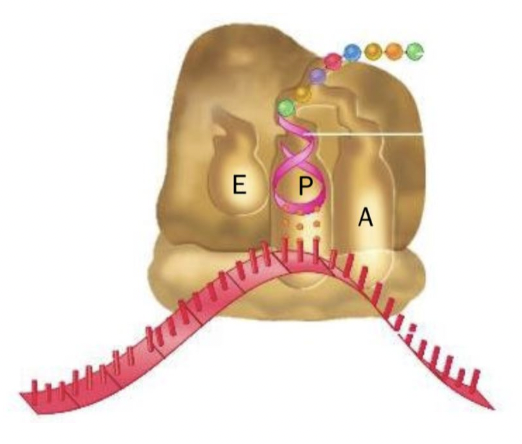
Which site on the ribosome matches each of the functions listed?
A site
P site
E site
Site where an uncharged tRNA leaves the ribosome
Site of aminoacyl-tRNA binding
Site that contains a tRNA with an attached peptide
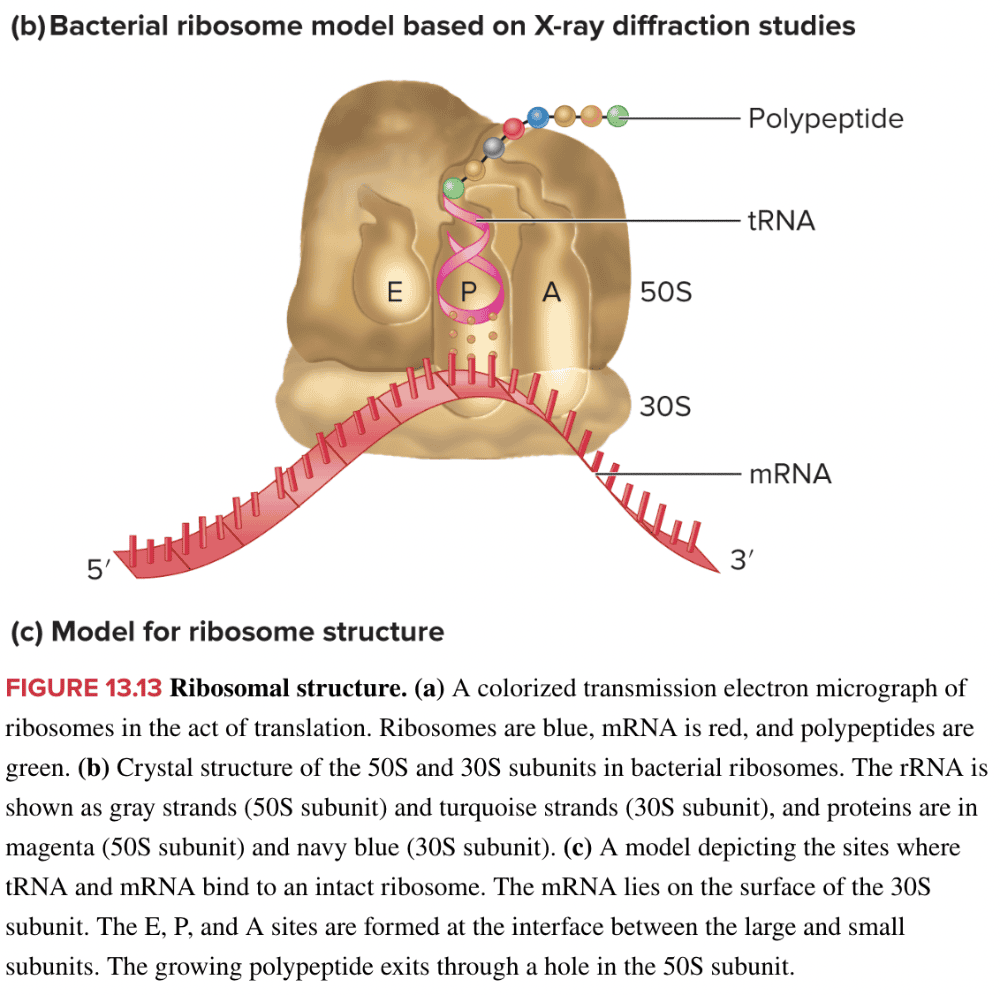
- A site Site of aminoacyl-tRNA binding
- P site Site that contains a tRNA with an attached peptide
- E site Site where an uncharged tRNA leaves the ribosome
In which cellular location would ribosomes be found for both prokaryotic and eukaryotic cells?
Multiple choice question.
Mitochondria and chloroplasts
Chloroplasts
Cytosol, mitochondria and chloroplasts
Cytosol
Mitochondria
Cytosol
Translation is divided into three stages: the first is ____, the next is ____, and the last is ____.
Blank 1: initiation
Blank 2: elongation
Blank 3: termination
In ______ cells, the initiator tRNA is carrying the amino acid N-formylmethionine.
Multiple choice question.
eukaryotic
prokaryotic
prokaryotic
What is the role of initiation factors IF1 and IF3?
Multiple choice question.
Promote the formation of the peptide bond
Promote the binding of the first transfer RNA to messenger RNA
Prevent messenger RNA from binding to the small ribosomal subunit
Promote messenger RNA binding to the ribosome
Prevent the small ribosomal subunit from associating with the large ribosomal subunit
Prevent the small ribosomal subunit from associating with the large ribosomal subunit
A 9-nucleotide sequence in prokaryotic mRNA that facilitates binding to the small ribosomal subunit is the ___-____ sequence.
Shine-Dalgarno
In forming the initiation complex, the factor that promotes the binding of the first tRNA to mRNA already bound to the 30S subunit is ______.
Multiple choice question.
Peptidyl transferase
Termination factor
IF3
IF2
IF1
IF2
Which description matches each stage of translation?
Initiation
Elongation
Termination
The newly produced polypeptide is released from the ribosome.
A complex forms between the ribosomal subunits, one mRNA molecule and the first tRNA molecule.
Amino acids are linked together in the order designated by the codons.
- Initiation A complex forms between the ribosomal subunits, one mRNA molecule and the first tRNA molecule.
- Elongation Amino acids are linked together in the order designated by the codons.
- Termination The newly produced polypeptide is released from the ribosome.
In prokaryotic cells, a transfer RNA carrying N-formylmethionine recognizes the ______ and is the first tRNA to bind to the ribosomal subunits, so it is called the initiator tRNA.
Multiple choice question.
operon
start codon
stop codon
promoter
exon
start codon
In prokaryotic cells, formation of the initiation complex requires the binding of tRNAfMet to the ____ site of the ribosome.
P
The Shine-Dalgarno sequence facilitates the binding of ______.
Multiple choice question.
mRNA to the large ribosomal subunit
the second tRNA to the A site of the ribosome
mRNA to the small ribosomal subunit
the first tRNA to the P site of the ribosome
mRNA to the small ribosomal subunit
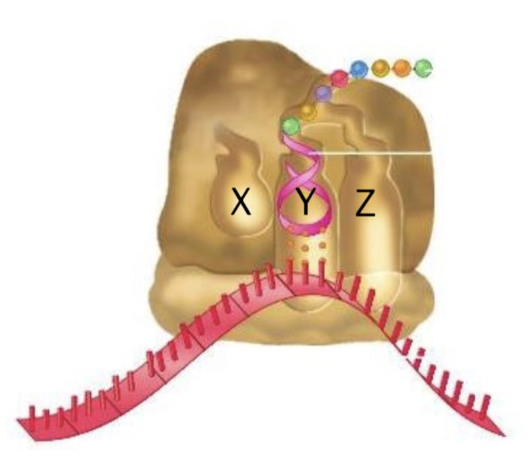
What is the name for each of the ribosomal sites, labeled as X, Y and Z on the accompanying figure?
X
Y
Z
E site
A site
P site
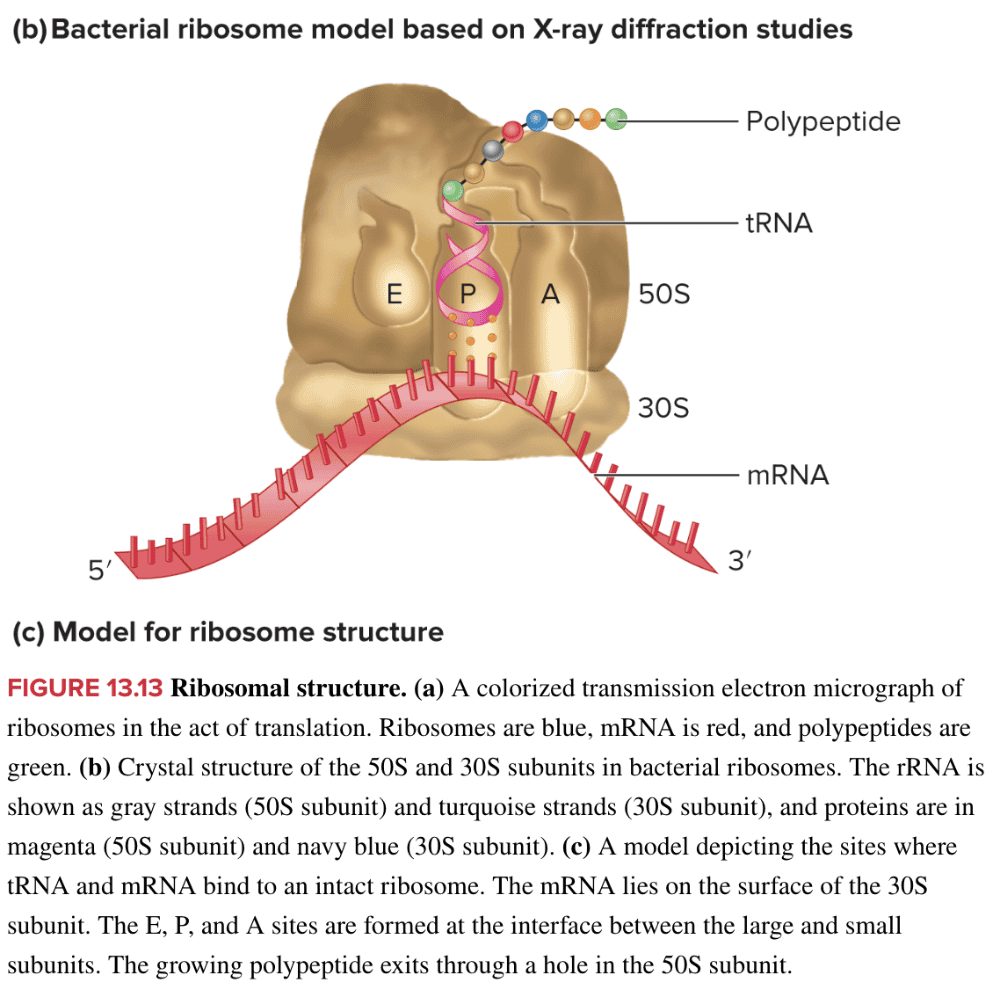
- X E site
- Y P site
- Z A site
At the end of translation, dissociation of the small and large ribosomal subunits in prokaryotes requires the binding of ____ to the ribosome.
IF1
In the formation of the initiation complex, binding of the first tRNA to the mRNA is promoted by the factor called
IF2
Select all that apply
For translation in vertebrates and vascular plants, the AUG used as the start codon requires specific bases in the surrounding sequences, including ______.
- a guanine at position +4
- a purine at position -3, preferably adenine
To which site does the transfer RNA carrying N-formylmethionine (tRNAfMet) bind when forming the initiation complex in prokaryotic cells?
P site
The stage of translation in which amino acids are added one at a time to a growing polypeptide chain is called
elongation
In prokaryotic cells, which factor must bind to the ribosome to cause the dissociation of the small and large ribosomal subunits at the end of translation?
IF1
Which factor hydrolyzes GTP to provide energy for translocation in bacterial translation?
Multiple choice question.
Peptidyl transferaase
EF-Tu
EF-G
EF-Ts
EF-G
For translation in vertebrates and vascular plants, the AUG chosen as the start codon will be ______.
Multiple choice question.
surrounded by specific bases as defined by Kozak's rules
the AUG closest to the 3' end of the mRNA
the AUG closest to the 5' end of the mRNA
the AUG closest to the Shine-Dalgarno sequence
surrounded by specific bases as defined by Kozak's rules
To begin each round of elongation during translation, the tRNA carrying the next amino acid to be added to the polypeptide chain binds to the ____ site of the ribosome.
A or aminoacyl
The order in which amino acids are added to a polypeptide chain is determined by hydrogen bonding between each codon and the ______ of the tRNA carrying the amino acid.
Multiple choice question.
5' end
stem-loop structures
variable bases
anticodon
acceptor stem
anticodon
Amino acids are added sequentially to a growing polypeptide chain during ______.
Multiple choice question.
elongation
termination
initiation
elongation
What provides the energy for binding of the next tRNA to the A site during elongation in prokaryotic cells?
Multiple choice question.
EF-Tu hydrolyzing GTP
EF-G hydrolyzing GTP
EF-Tu hydrolyzing ATP
EF-Ts hydrolyzing GTP
EF-Tu hydrolyzing GTP
In prokaryotic translation, what provides the energy for translocation?
Multiple choice question.
EF-G hydrolyzing GTP
EF-Ts hydrolyzing GTP
EF-Tu hydrolyzing GTP
EF-G hydrolyzing ATP
EF-G hydrolyzing GTP
The 16S rRNA of the ribosome will prevent elongation until a mispaired tRNA is released from the A site. This process is termed the ____ function of the ribosome, and is important in maintaining high fidelity in translation.
decoding
To begin each round of elongation during translation, a tRNA carrying the next amino acid to be added to the polypeptide binds to which of the following?
Multiple choice question.
Shine-Dalgarno sequence
A site on the ribosome
P site on the ribosome
E site on the ribosome
A site on the ribosome
During elongation, the ______ of the incoming tRNA binds to the ______ of the mRNA.
Multiple choice question.
anticodon; codon
codon; amino acid
elongation factor; initiation factor
amino acid; codon
codon; anticodon
anticodon; codon
During elongation, the enzyme that catalyzes the transfer of the polypeptide in the P site to the amino acid in the A site is ______.
Multiple choice question.
aminoacyl tRNA synthetase
RNA polymerase
peptidyl transferase
polypeptide synthetase
peptidyl transferase
The movement of the ribosome to the next codon that occurs after the peptidyl transfer reaction is called ______.
Multiple choice question.
elongation
initiation
translocation
termination
translocation
For elongation in prokaryotic cells, which factor hydrolyzes GTP to provide energy for binding of the next tRNA to the A site?
Multiple choice question.
EF-Ts
EF-G
eEF2
eEF1α
EF-Tu
EF-Tu
Termination of translation occurs when the ribosome reaches a ____ codon in the mRNA.
stop, termination, or nonsense
Which component of the ribosome can recognize a tRNA that is not correctly matched with an mRNA codon?
Multiple choice question.
16S rRNA
5S rRNA
50S ribosomal subunit
30S ribosomal subunit
23S rRNA
16S rRNA
The component that recognizes a stop codon at termination of translation is ______.
Multiple choice question.
a terminating transfer RNA
peptidyl transferase
23S rRNA
a protein called release factor
16S rRNA
a protein called release factor
The transfer of the polypeptide in the P site to the amino acid in the A site during elongation is catalyzed by the enzyme ____ ____.
Blank 1: peptidyl, peptidyl transferase, peptidal, or peptidyle
Blank 2: transferase
Studies of the three-dimensional structures of release factors show that they resemble the structure of ____ molecules.
tRNA or tRNAs
Movement of the ribosome so that the tRNA in the P site is shifted to the E site while the tRNA in the A site is shifted to the P site is called ______.
Multiple choice question.
initiation
translocation
elongation
termination
translocation
In prokaryotic cells, the coupling of transcription and translation refers to ______.
Multiple choice question.
translation of an mRNA beginning before its transcription has been completed.
both transcription and translation occurring in the nucleus
transcription of an mRNA occurring before its translation has been completed
both transcription and translation occurring on the ribosome
translation of an mRNA beginning before its transcription has been completed.
The stage of translation that occurs when a ribosome reaches a stop codon is called ____.
termination
Select all that apply
Which of the following occurs in eukaryotic translation but not in prokaryotic translation?
Multiple select question.
An 80S ribosome is used for translation
tRNAf-Met is the initiator tRNA
Release factors eRF1 and eRF3 are required
Translation begins before transcription has been completed
Start codon is selected according to Kozak's rules
An 80S ribosome is used for translation
Release factors eRF1 and eRF3 are required
Start codon is selected according to Kozak's rules
At termination of translation, a stop codon is recognized by a(n) ____ ____.
Blank 1: release, release factor, or releasing
Blank 2: factor, factors, or Factor
The antibiotic chloramphenicol binds to the 50S ribosomal subunit and prevents the formation of peptide bonds. This would inhibit protein synthesis in ______ cells.
Multiple choice question.
prokaryotic
neither prokaryotic nor eukaryotic
both prokaryotic and eukaryotic
eukaryotic
prokaryotic
Release factors appear to be "molecular mimics", resembling the structure of ______.
Multiple choice question.
mRNAs
tRNAs
50S ribosomal subunits
5S rRNA
23S rRNA
tRNAs
In prokaryotic cells, translation of an mRNA begins before its transcription has been completed. This phenomenon is called ____ of transcription and translation.
coupling or coupled
Select all that apply
Which of the following is used in prokaryotic translation but not in eukaryotic translation?
Multiple select question.
tRNAf-Met as the initiator tRNA
IF1, IF2 and IF3 as initiation factors
80S ribosomes
Shine-Dalgarno sequence to facilitate mRNA binding to the small ribosomal subunit
7-methylguanosine cap on mRNA to facilitate binding to the small ribosomal subunit
tRNAf-Met as the initiator tRNA
IF1, IF2 and IF3 as initiation factors
Shine-Dalgarno sequence to facilitate mRNA binding to the small ribosomal subunit
Some antibiotics can be used to inhibit the growth of prokaryotic cells without harming their eukaryotic hosts because they are small molecules that bind only to prokaryotic ribosomes preventing ______.
Multiple choice question.
DNA replication
protein synthesis
the formation of mRNA
the formation of tRNA
protein synthesis
